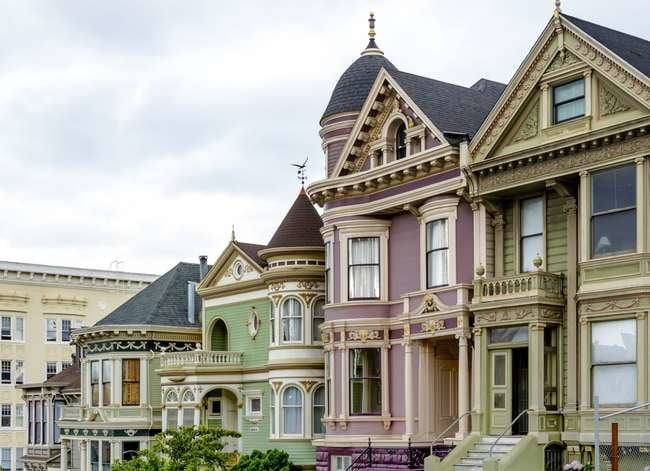

We may earn revenue from the products available on this page and participate in affiliate programs. Learn More ›
Home Advice You Can Trust
Tips, tricks & ideas for a better home and yard, delivered to your inbox daily.
By signing up you agree to our Terms of Service and Privacy Policy.
Visit Them All!
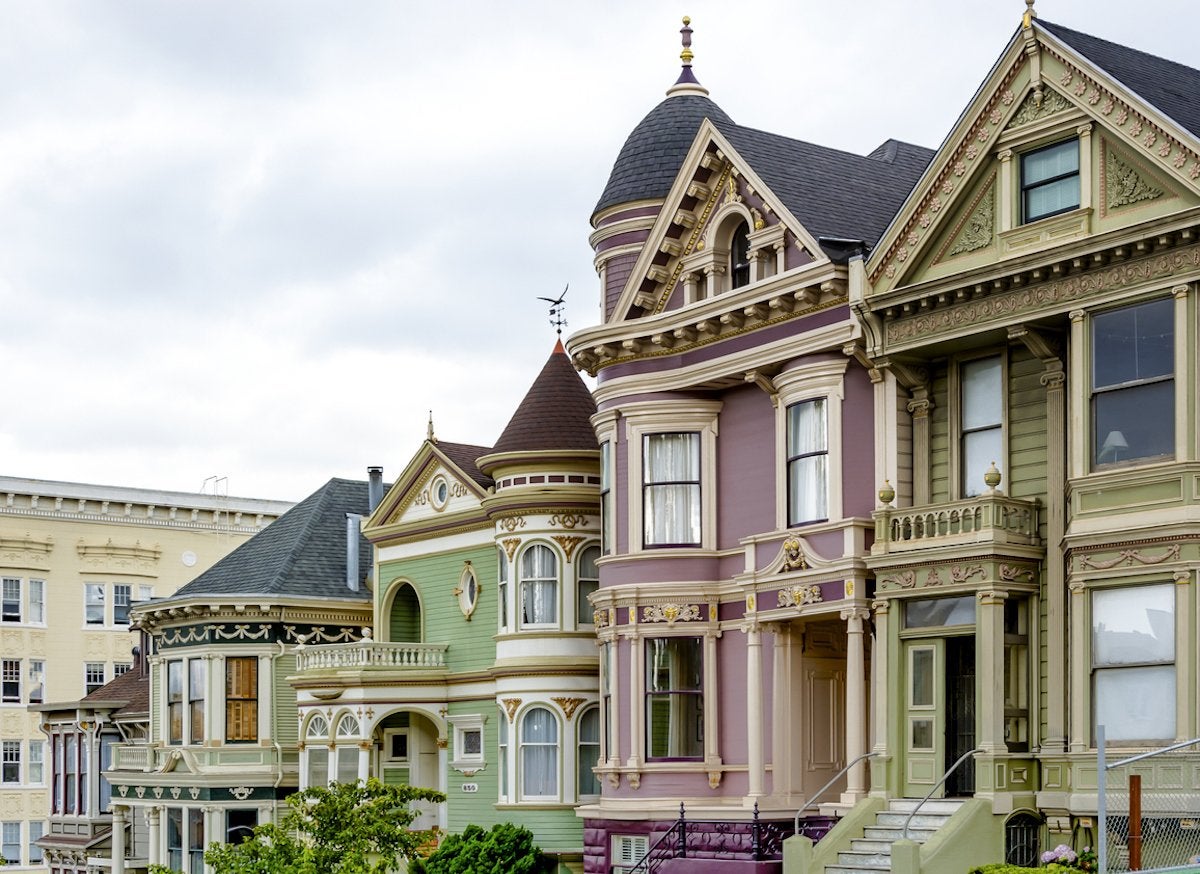
Have you ever driven past a distinctive dwelling and wondered what—or who—is inside? While many fascinating abodes across the country are worth exploring, the majority are off limits to the public, which makes those that welcome visitors true treasures to behold. Scroll through for the most architecturally and historically significant homes in each state that open their doors to the public, and then schedule a tour of the one nearest you.
Alabama – Rosenbaum House
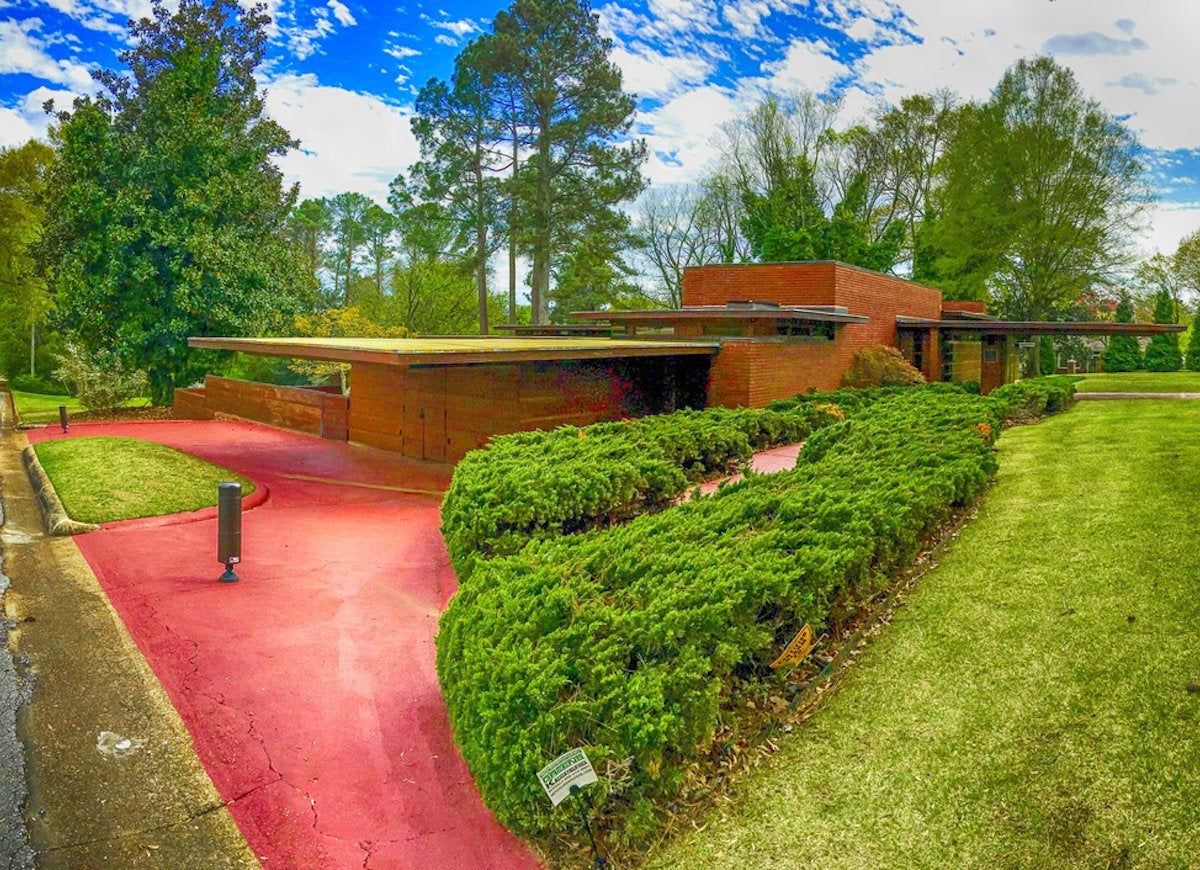
The only Frank Lloyd Wright building in Alabama, this futuristic home in Florence was built for Stanley and Mildred Rosenbaum, a young couple who went on to raise four sons within its walls. Typical of the Usonian style, the home is L-shaped and incorporates native materials, in this instance cypress and brick. The strong horizontal lines of its cantilevered roofs visually anchor the structure to the site, and expanses of windows blur the distinction between indoors and out. Further uniting the home and its surroundings, most bedrooms include a door to the outside. Tour it yourself from Tuesday through Sunday for $10.
Alaska – Erskine House
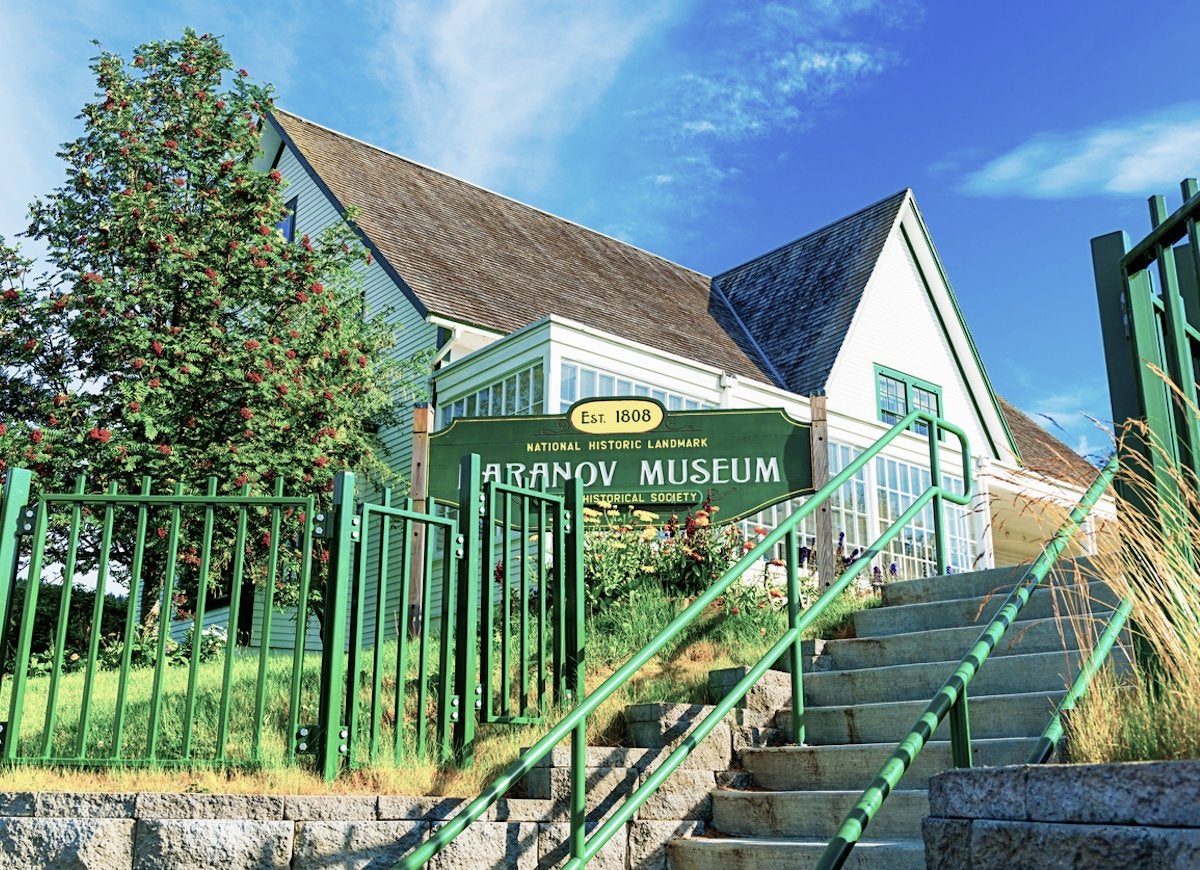
For a glimpse into life in Kodiak when it was a Russian settlement, tour the Erskine House, the oldest Russian-built structure in the country. Erected circa 1810 as a storage facility, in 1911 it became the residence of businessman W.J. Erskine, who then lived there for 30 years. Clad in redwood siding and topped with a dramatic gabled roof, the building now hosts the Kodiak History Museum, rife with exhibits on the history of the Kodiak Archipelago and the Aleutian Islands. Adventurers can see it all on a house tour, from Tuesday through Saturday; $10 per adult.
Arizona – Taliesin West
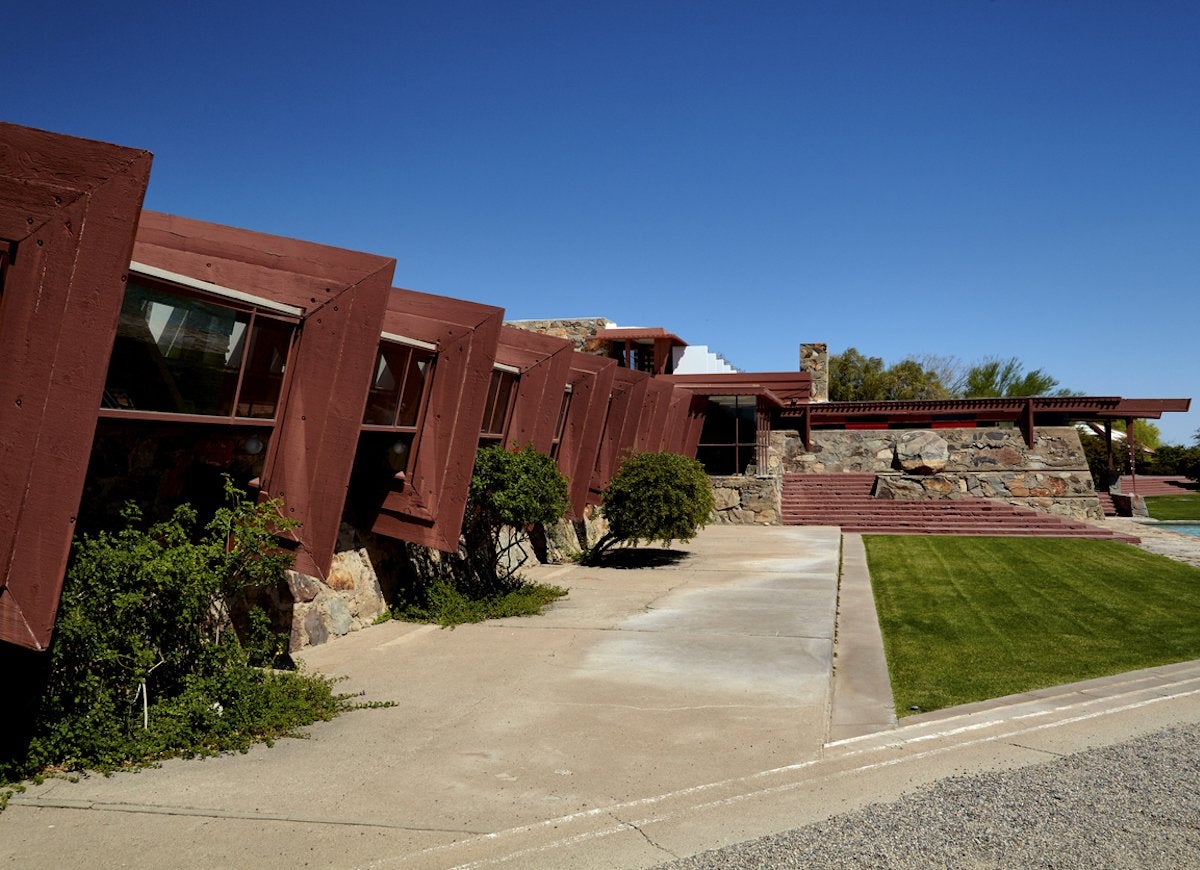
Now the home of the Frank Lloyd Wright Foundation and the School of Architecture at Taliesin, this desert-inspired dwelling in Scottsdale was built in 1937 to serve as Wright’s winter home. Among its many impressive architectural elements, the hexagonal rock cabaret theater, light-filled garden room, and shimmering pool best exemplify Wright’s lifelong love of nature. You can see these sights and more on a selection of tours, with tickets ranging from $35 to $75, any day of the year except Easter, Thanksgiving, and Christmas.
Arkansas – Peel Mansion
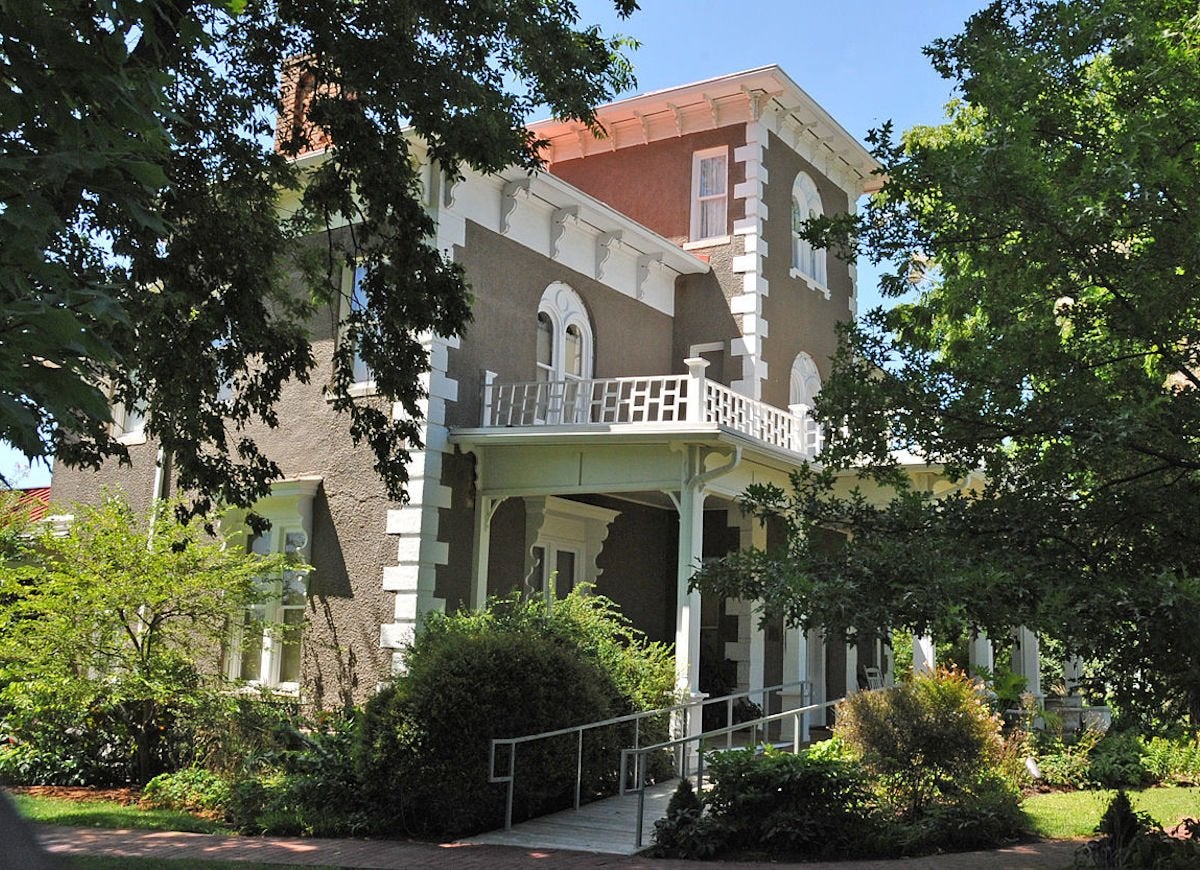
Wikimedia Commons via JERRYE & ROY KLOTZ MD
Like a time capsule from 1875, the year it was built by Colonel Samuel West Peel, the Peel Mansion captures a slice of life in the post-Civil War South. The Italianate mansion in Bentonville features a Victorian interior complete with period rugs, an imposing staircase with a graceful walnut balustrade, a rare Anglo-Japanese mantel in the library, and Greek Revival trim in the parlor. To make the surrounding heritage garden as period authentic as possible, descendants of the region’s early settlers were interviewed to find out what plants they remembered from the gardens of their youth. Visiting the mansion and grounds is like taking a trip back to the 19th century. Options include free guided or self-guided tours, or a group tour with lunch or breakfast ($20 per guest).
California – Winchester Mystery House
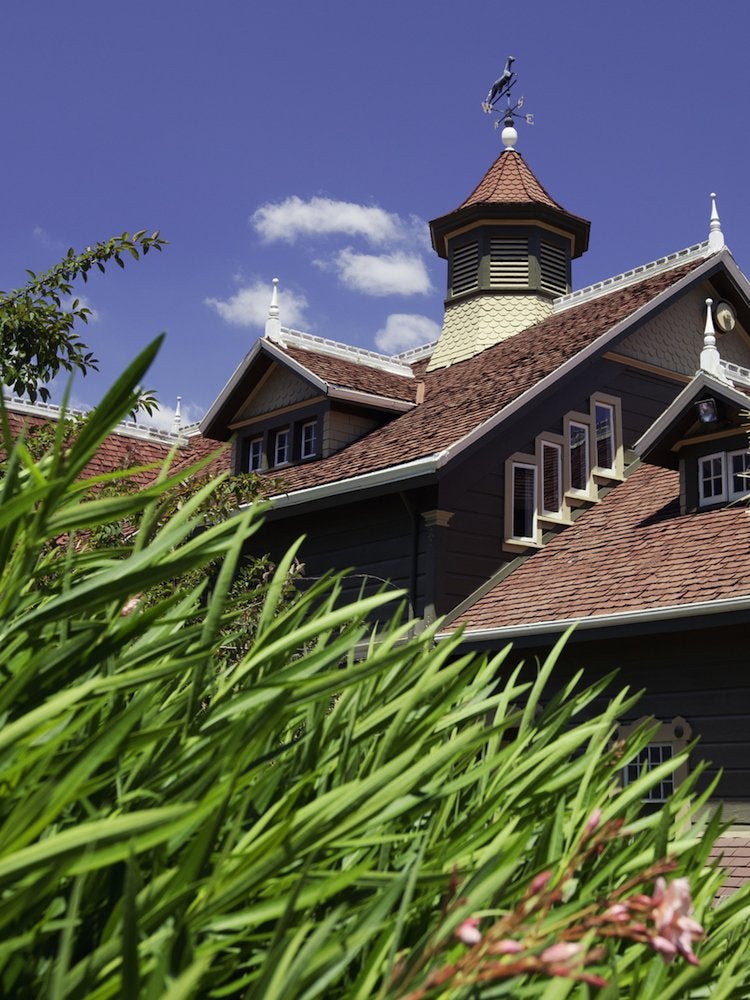
When a psychic informed Sarah Winchester that the untimely deaths of her daughter and her gun magnate husband were the work of ghosts, she took it to heart and moved from Connecticut to San Jose, where she built a quirky, palatial property packed with booby traps to thwart evil spirits. On a tour of the 160-room home, you’ll notice a freaky floor plan, sealed rooms, and doors that lead to several-foot drops. Construction began in 1884, and some say that it did not stop until Winchester’s death in 1922. This unfinished business is perhaps why her ghost is rumored to haunt the house to this day. See the eccentric estate up close daily (except for Christmas Day) on one of a selection of tours that range from $20 to $54.
Colorado – The Molly Brown House
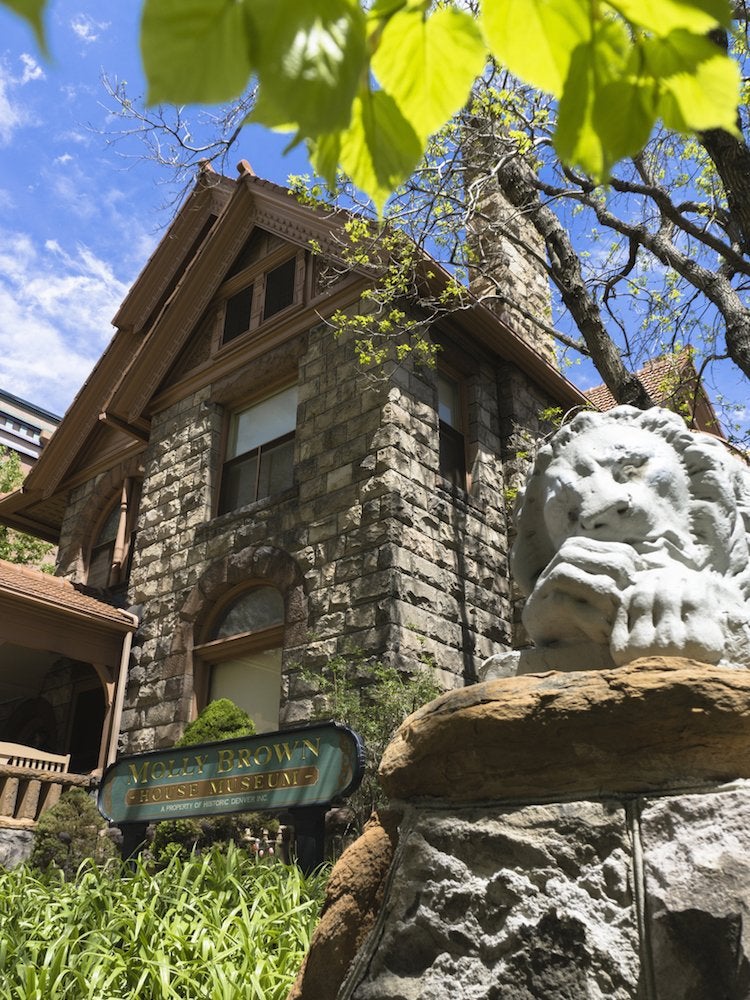
Known as “The Unsinkable Molly Brown” for having survived the sinking of the Titanic, the energetic, ambitious Brown went on to live in a house with an enduring appeal every bit as notable as her own. Built in the 1880s, the Queen Anne-meets-Richardsonian Romanesque mansion had all the modern amenities of the day, including electricity, indoor plumbing, and the telephone. After Brown passed away in 1932, her Denver home was sold, later becoming a rooming house and then a home for poor and immigrant girls. Saved from demolition in the 1970s, the house is now a carefully restored museum, filled with exhibits recounting Brown’s long record of activism and philanthropy. Soak them all in Tuesday through Sunday for $13.
Connecticut – Gillette Castle
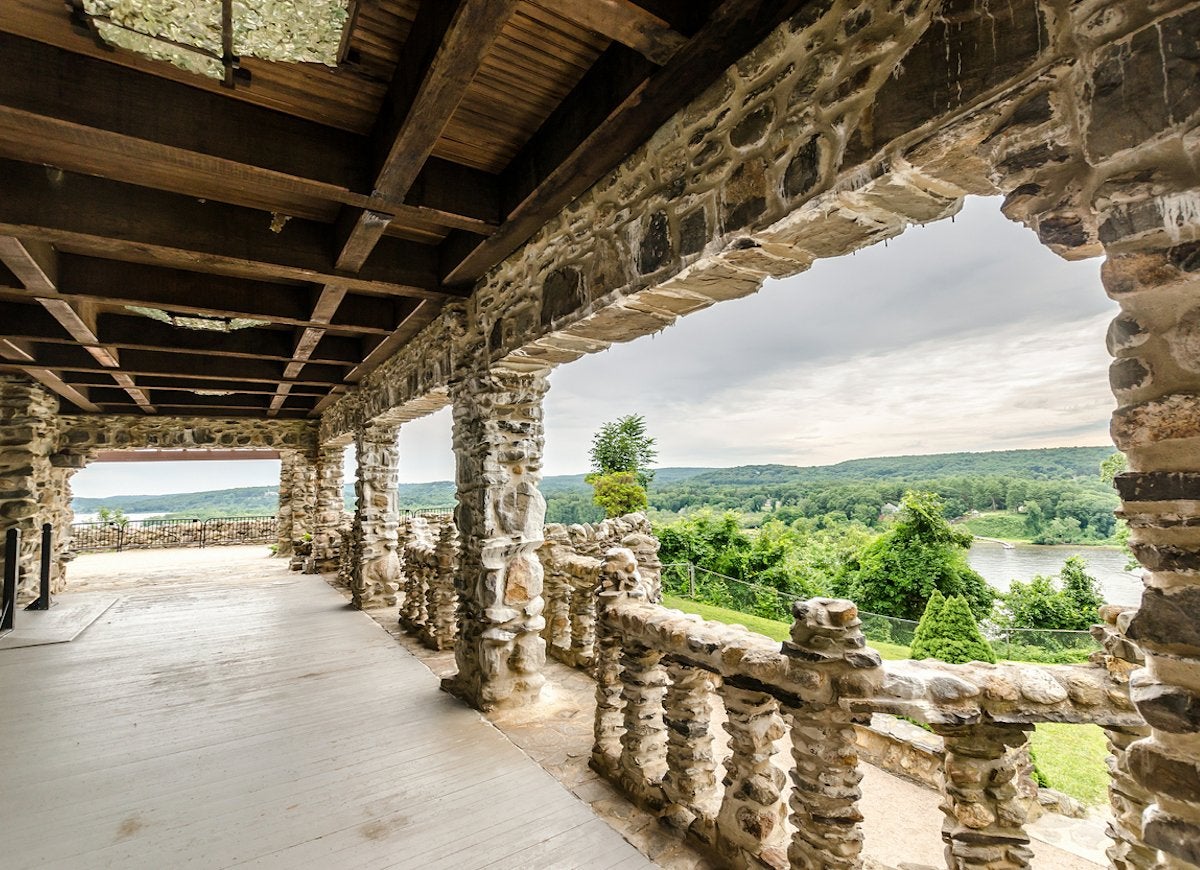
Twenty men toiled for five years, from 1914 to 1919, to build this 24-room medieval-style castle where William Gillette retreated upon his semi-retirement from directing, acting, and playwriting. The creative eccentricities of Gillette, who painstakingly oversaw the construction, suffuse every square inch of the fieldstone-and-steel castle, from the carved wood light switches to a table that moves on tracks. Now part of Gillette Castle State Park in East Haddam, the site is open for tours from mid-Spring through mid-October; general admission tickets are $6.
Delaware – Nemours Mansion and Gardens
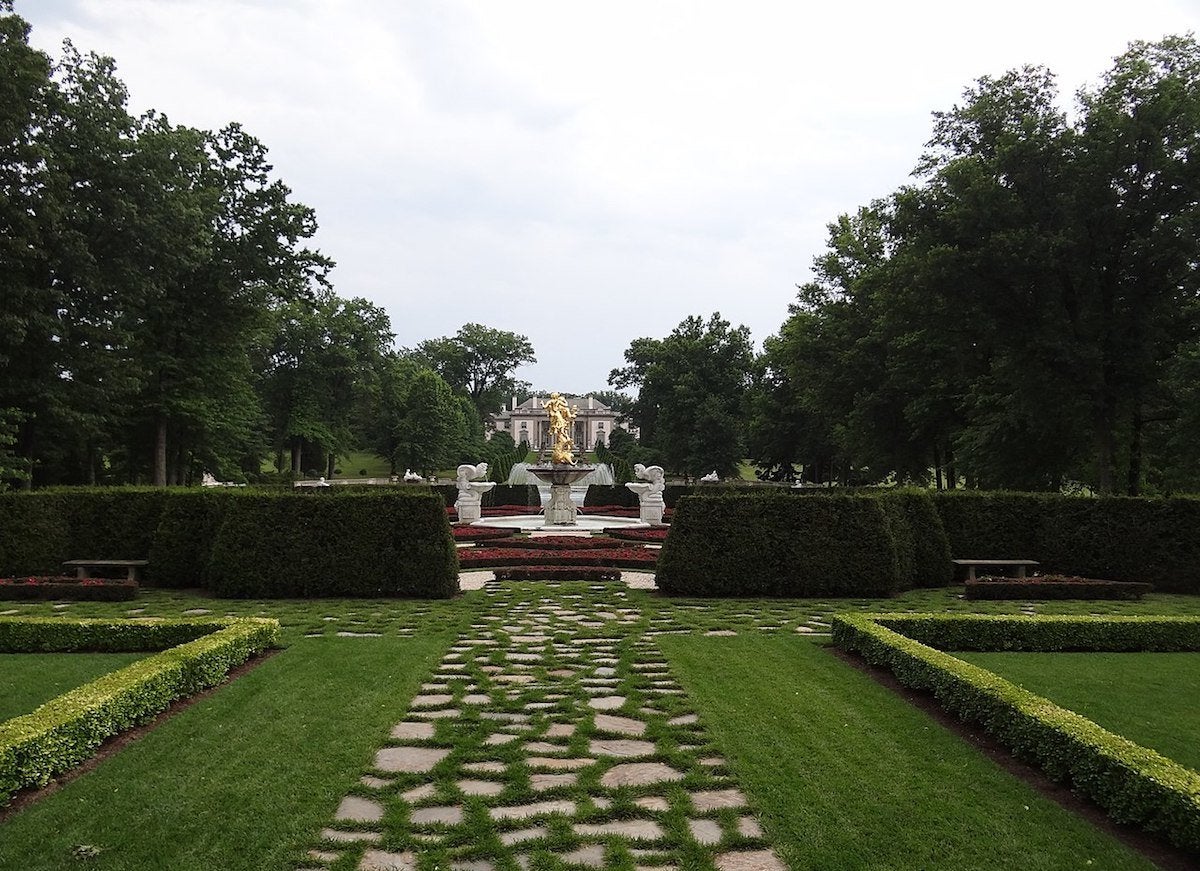
Wikimedia Commons via Esther Westerveld
If the Palace of Versailles is on your bucket list, but airfare to France isn’t in your budget, head instead to this chateau in Wilmington. The regal residence, a gift from industrialist Alfred I. du Pont to his second wife, boasts the largest French-style garden in North America, inspired by the gardens of Versailles. Indoors, visitors can admire notable artworks and opulent furnishings as well as a bowling alley, a billiards table, and the estate’s collection of vintage cars. Tours are offered Tuesday through Sunday for $18.
Florida – Audubon House
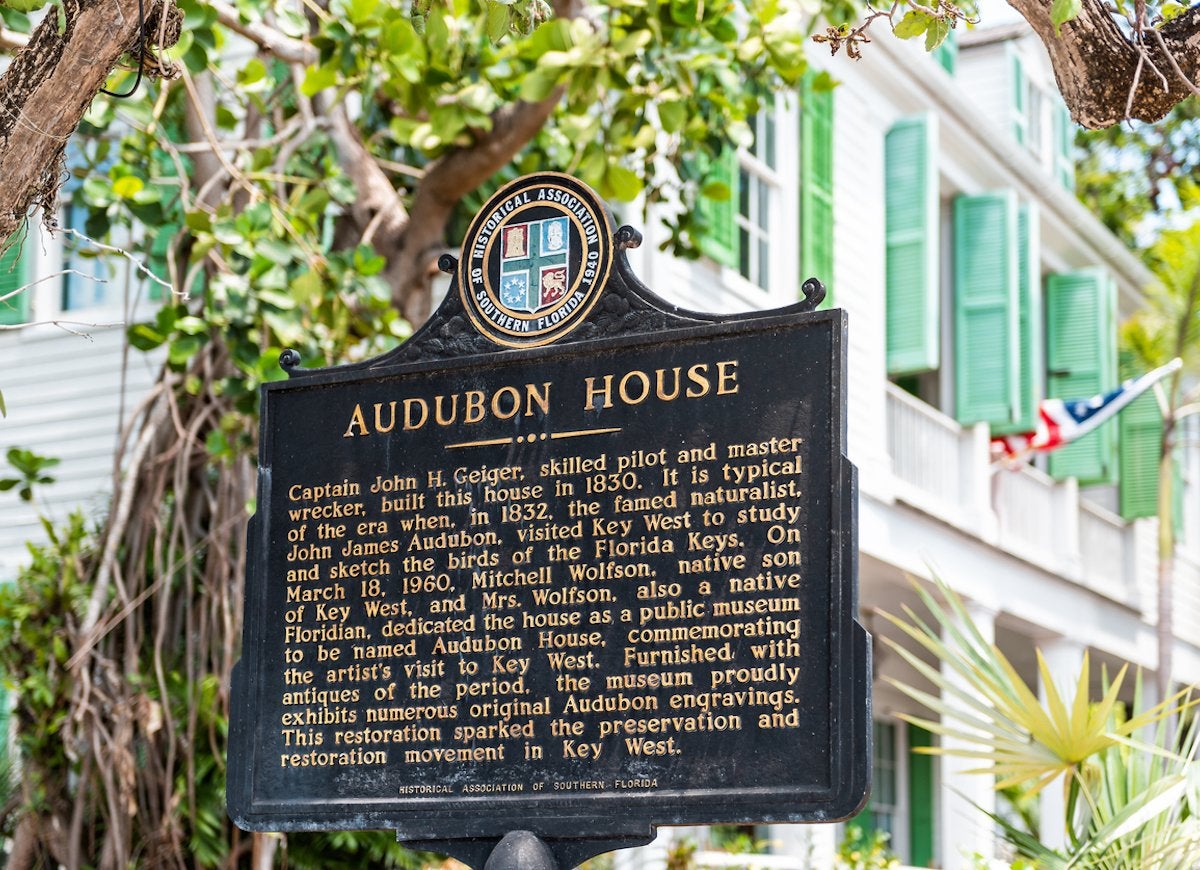
By the time American ornithologist and naturalist John J. Audubon had departed Key West in 1832, he had identified some 18 new birds. According to local folklore, many of his drawings of these winged beauties were thought to have been sketched on the Key West property where, in the 1840s, Captain John Huling Geiger later built the home that now bears Audubon’s name. The estate also displays 28 of the ornithologist’s first-edition works. Admire them up close daily for $14.
Georgia – Swan House
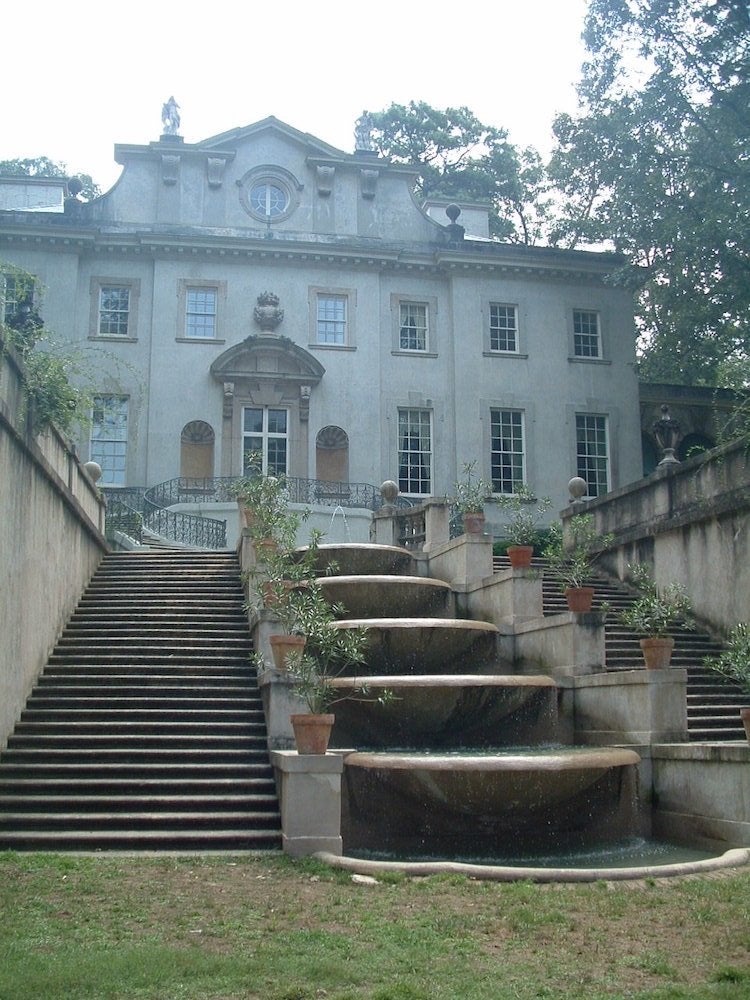
Wikimedia Commons via Ingamun
The next time you’re in Atlanta, relive movie history by strolling through this house museum that was used as a location for “The Hunger Games: Catching Fire,” among other films. Although onscreen the Second Renaissance Revival mansion served as the villainous President Snow’s palace, its off-screen life has been more serene. Built in 1928 for cotton tycoons Edward and Emily Inman, the property features elaborate interiors, stately grounds, and a recurring swan motif with painted and sculptured swans indoors and out. Self-guided tours are included with general admission to Atlanta History Center ($21.50); a guided tour is an additional $10. Swan House also offers a “Behind the Scenes” tour, which visits rooms not on view in the regular tour, for $31.50 (this price includes History Center admission).
Hawaii – Liljestrand House
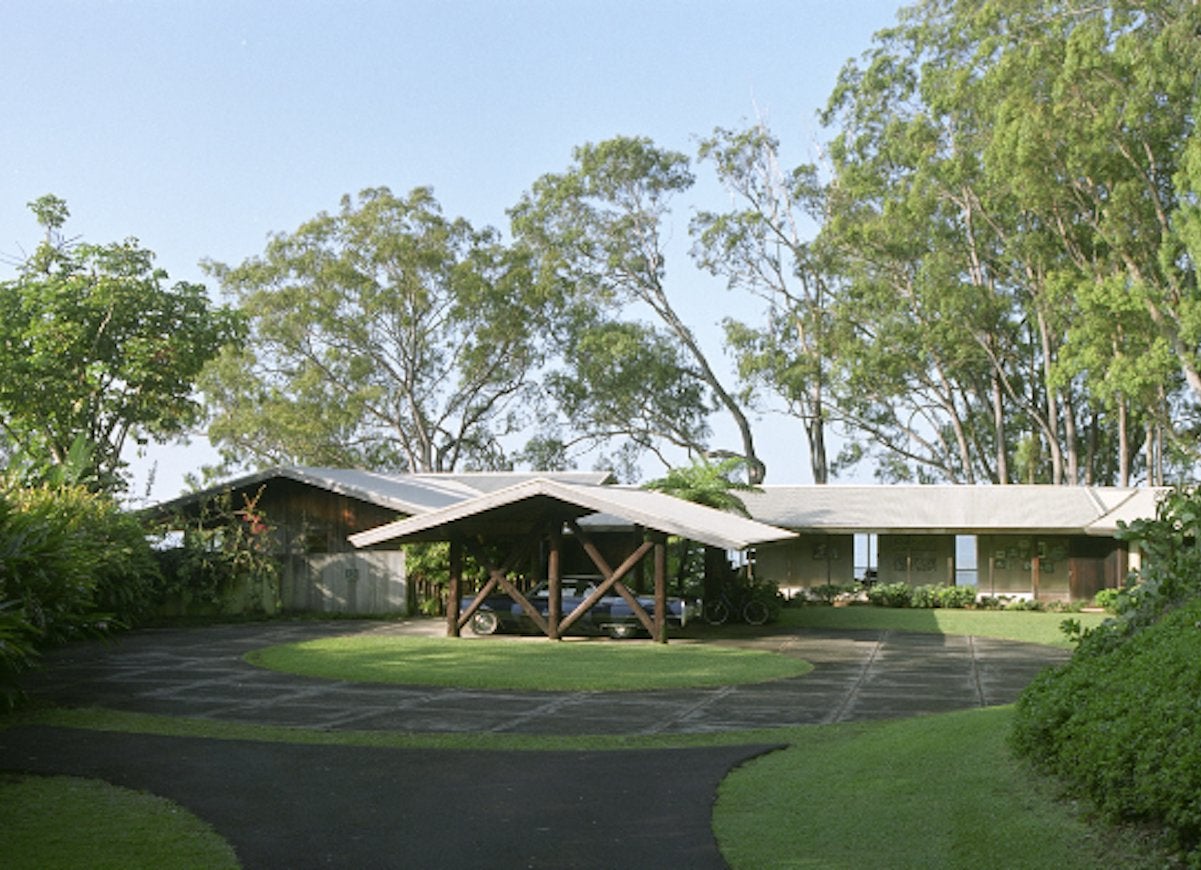
Wikimedia Commons via Bob Liljestrand
During a hike in 1946, Howard and Betty Liljestrand stumbled on a secluded spot on a hillside above downtown Honolulu and vowed to make it home. By 1952, a Hawaiian Modern-style house, designed by architect Vladimir Ossipoff, stood on the parcel of land. Sensitive to the demands of the site, the structure sits on two terraces, and the master bedroom is angled to preserve a stand of ancient eucalyptus trees. Request a tour, and you’ll be able to savor the dramatic views from every room of this meticulously crafted home.
Idaho – Parish House
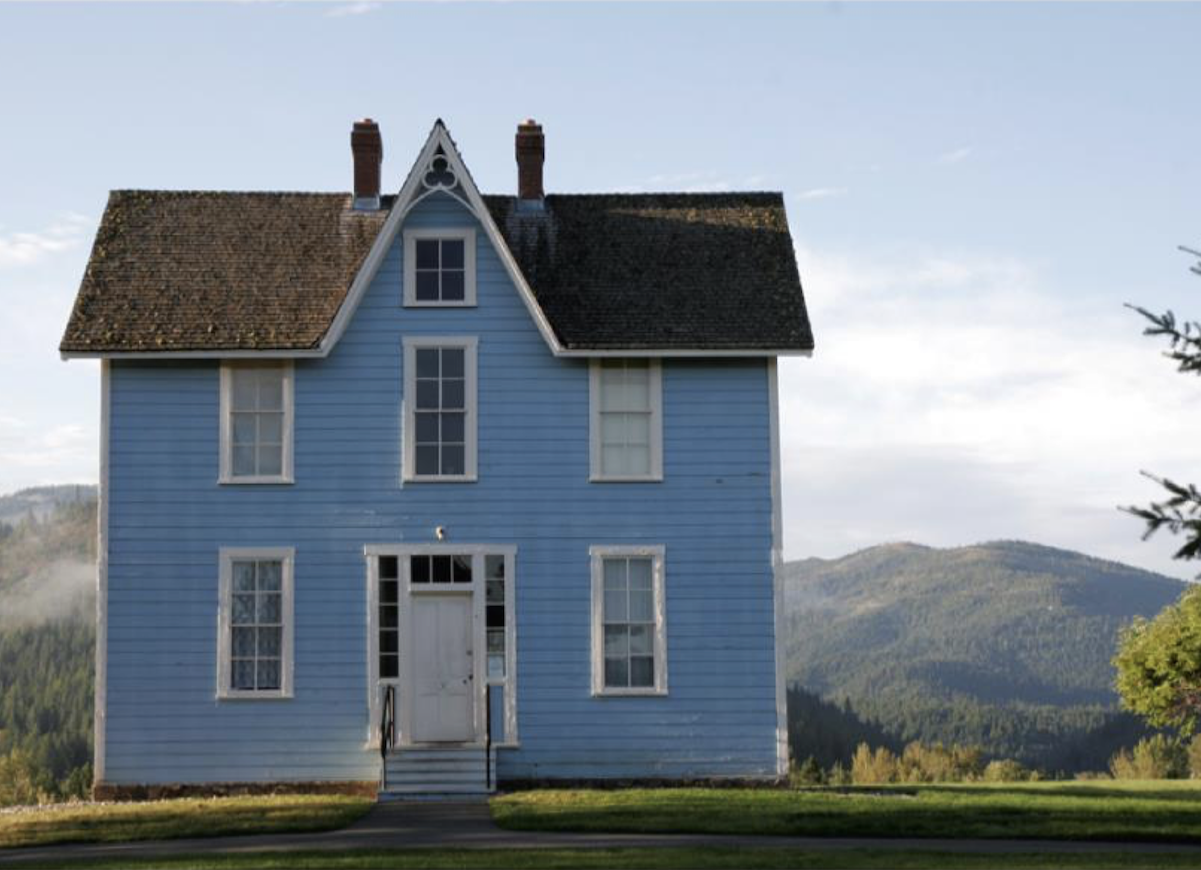
What was known initially as Sacred Heart Mission was built between 1850 and 1853, at the direction of Jesuit missionaries and with the labor of Coeur d’Alene tribe members. The current parish house was built in 1887 after fires destroyed earlier buildings. In addition to the parish house, the site of the mission, which is now part of Old Mission State Park, comprises Sacred Heart Church (1853), two cemeteries, and a visitor’s center. The mission stands as a symbol of the clash and interplay of Native American and European religions and cultures in the 19th century. A $5 fee grants entrance to Old Mission State Park and the various buildings within.
Illinois – Farnsworth House
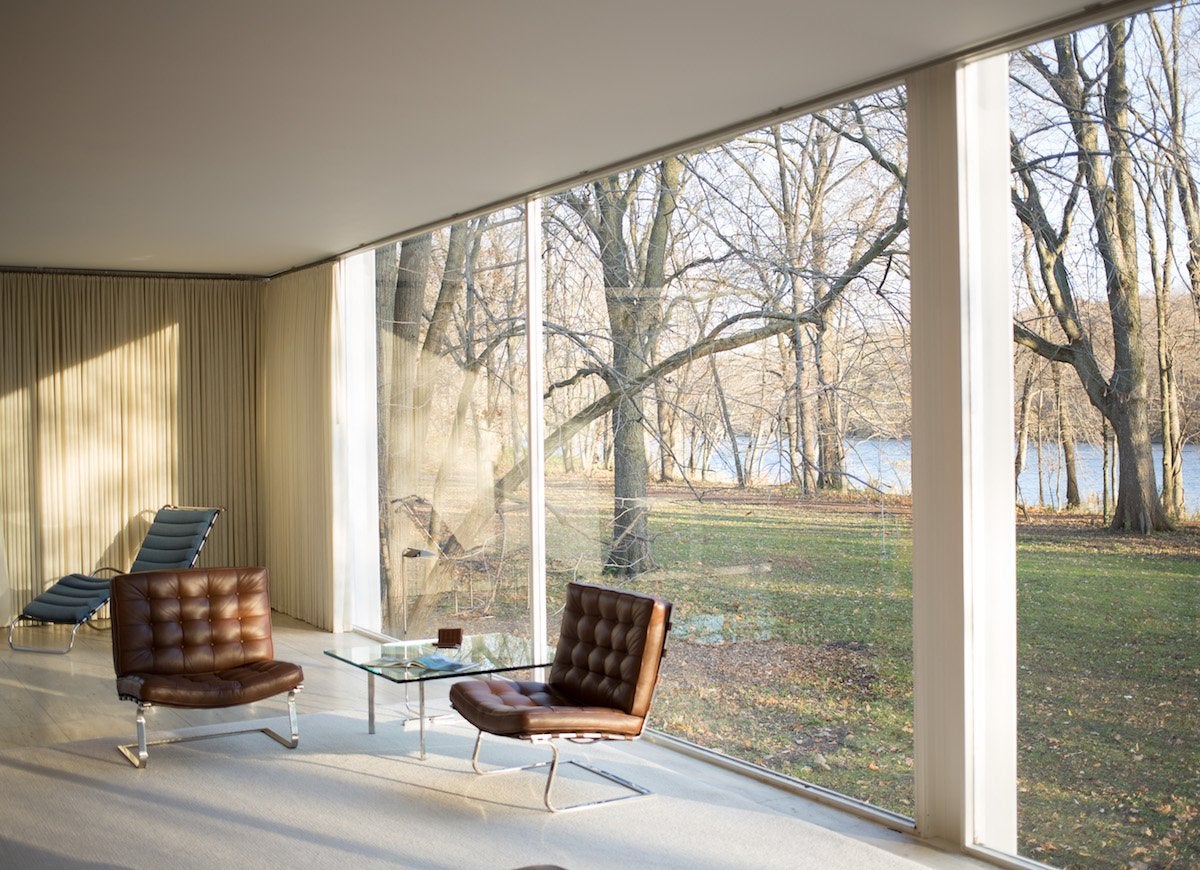
Wikimedia Commons via Victor Grigas
Although architect Ludwig Mies van der Rohe, a founding father of modernism, is perhaps best known today for towering glass-and-steel icons like the Seagram Building in New York City, this daring International Style house in Plano is perfection on a smaller scale. Built between 1945 and 1951 for nephrologist Edith Farnsworth, the one-room wonder with floor-to-ceiling glass walls and an open terrace doesn’t provide the occupant with much cover. But a screened porch and a tall black maple tree provide some privacy and shade—as you can see for yourself during a guided tour, available for $20.
Indiana – Samara
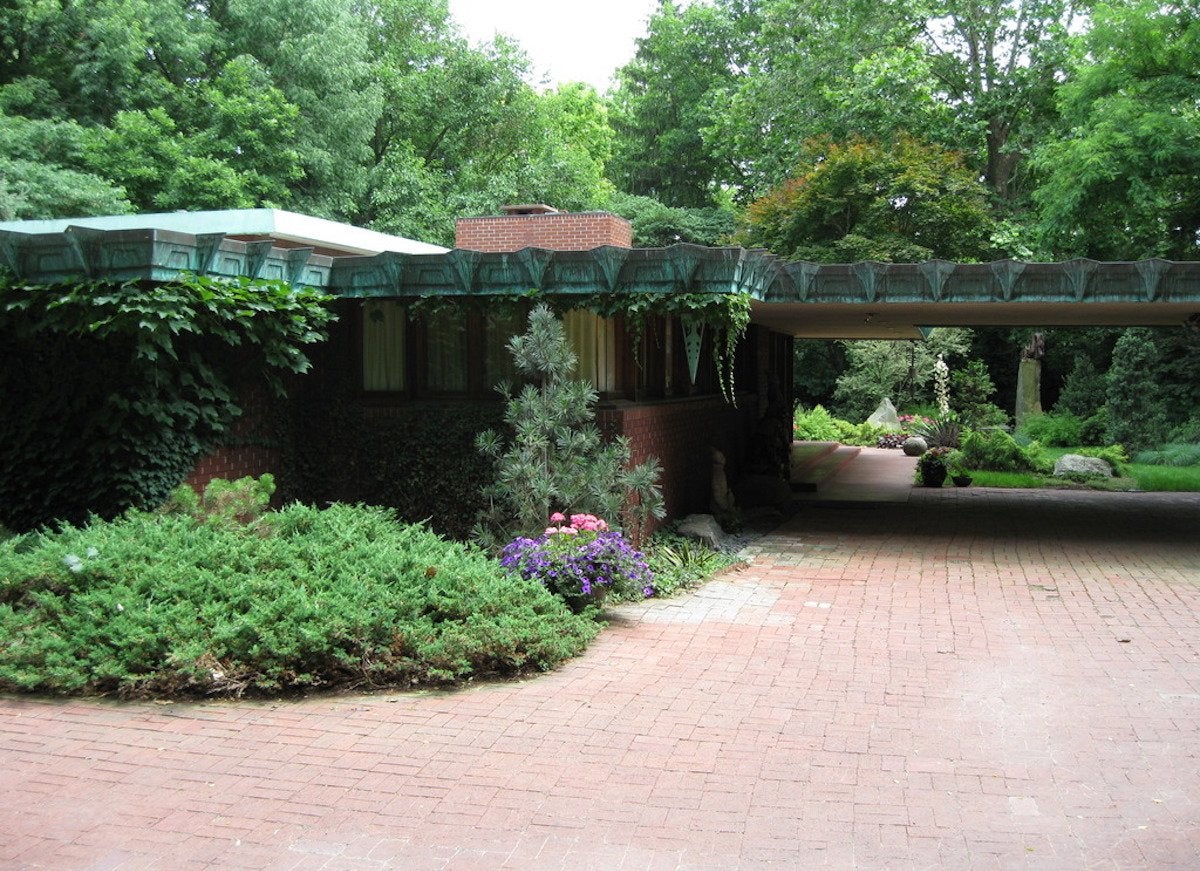
Wikimedia Commons via Tim Musson
Named for the winged seeds in pine cones, this Usonian landmark in West Lafayette was designed by Frank Lloyd Wright for John and Kay Christian, who both worked at nearby Purdue University. Designed toward the end of Wright’s career, Samara seemed destined for icon status from the outset. Today, the clerestory windows, the uncharacteristically saturated color palette of lime green and purple, and dining chairs emblazoned with chevron-shaped leaves wow even those unfamiliar with the famous architect. Schedule a tour of this Wright masterpiece from April through the end of November for $10.
Iowa – American Gothic House
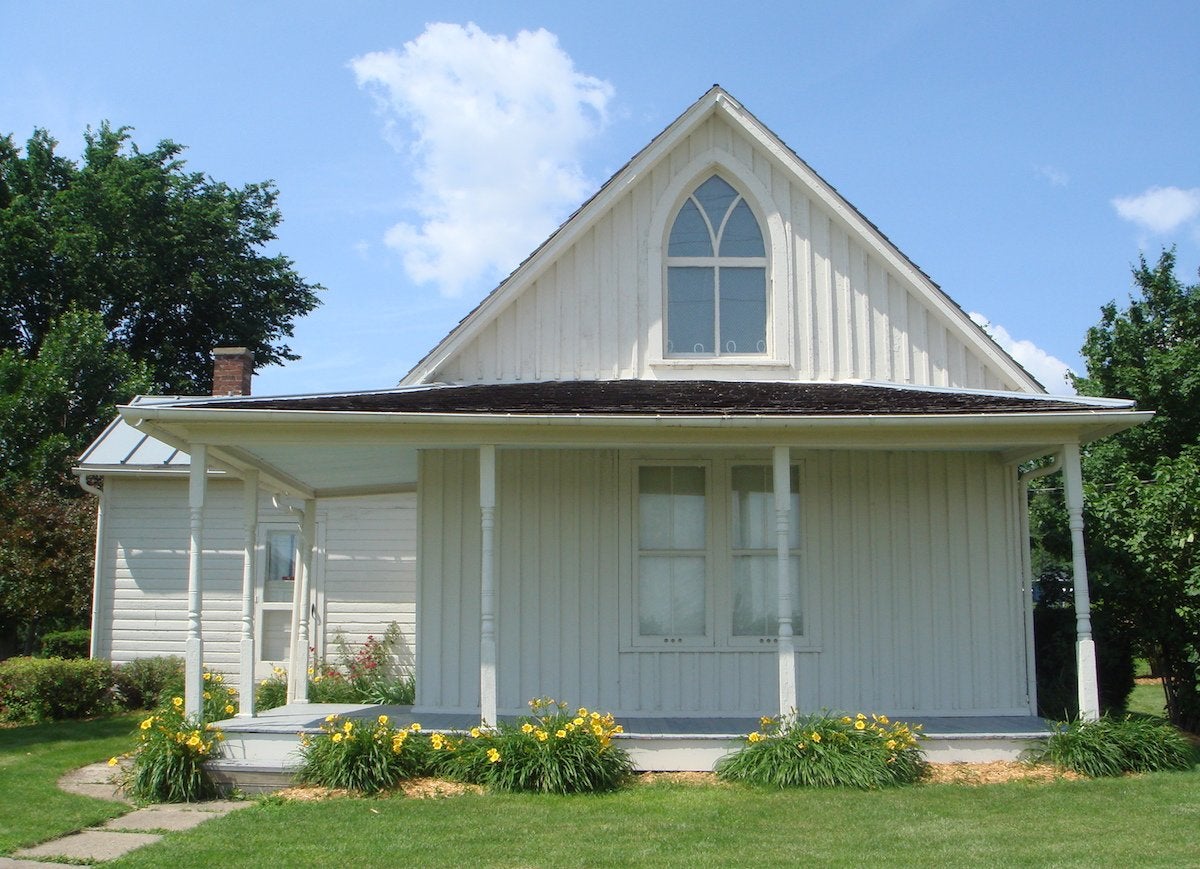
Wikimedia Commons via Jessica Strom
Although a woman and a pitchfork-wielding man steal the scene in Grant Wood’s most famous painting, “American Gothic,” it’s the humble house in the background that truly captures the stolid spirit of 20th century rural America. That house, previously known as the Dibble House, was inspired by the residence of Charles and Catharine Dibble. Built around 1882, the Carpenter Gothic dwelling in Eldon totals a mere 504 square feet and features white board-and-batten siding and a prominent Gothic-style window. After viewing the house in 1930, Wood himself found it unremarkable but “very paintable.” Judge for yourself on a free tour, the second Saturday of every month, from April through October.
Kansas – Subterra Castle
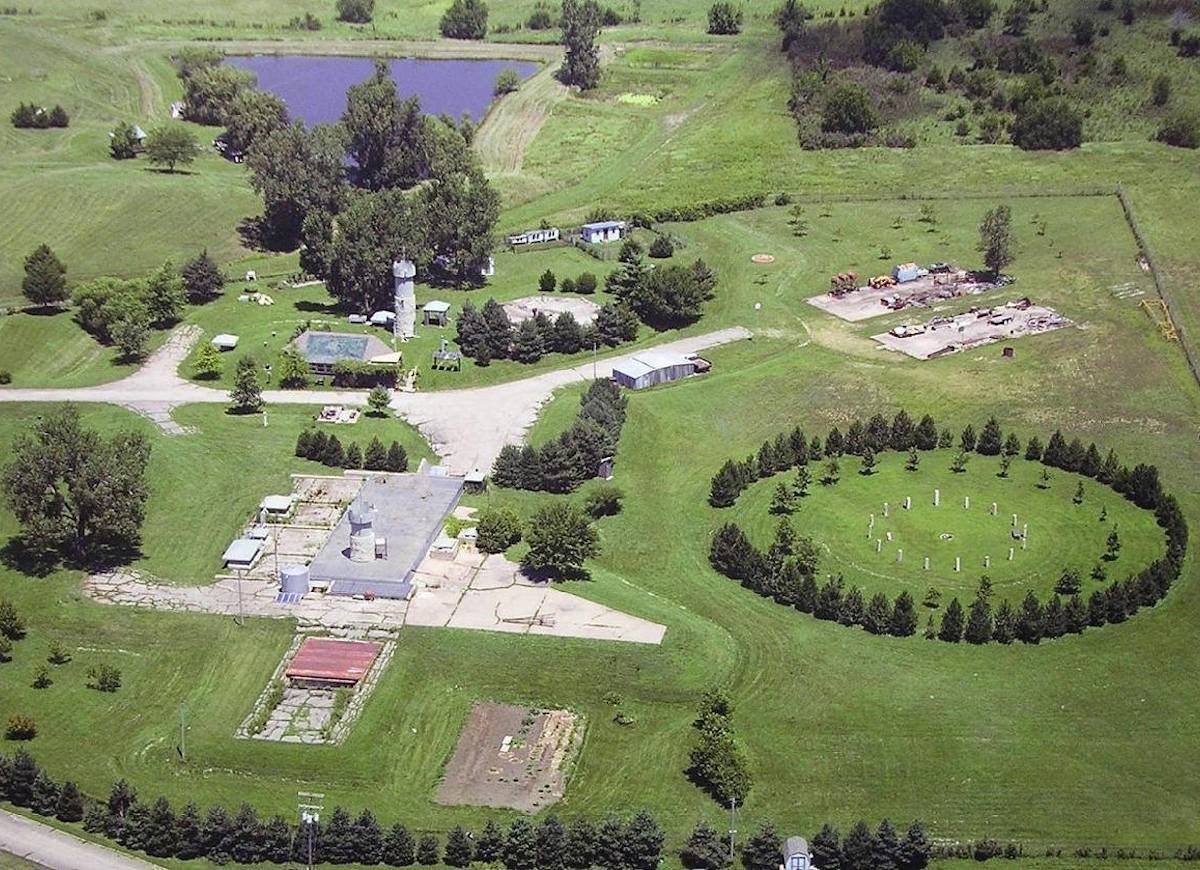
Facebook via 20th Century Castles, LLC
A Cold War relic, this disused underground missile launch complex located outside Topeka was purchased for $40,000 in 1982 by Edward and Dianna Peden—a steal given the $4 million it cost the government to build. A lot of legwork went into turning it into a home: When Edward first opened the garage, it contained a 78-foot missile topped with an atom bomb! Since 1994, the Pedens have been living underground in the converted compound, offering tours and hosting educational events. If you find that the underground life appeals to you, the couple will help you buy and convert an atomic bunker of your own.
Kentucky – Loudoun House
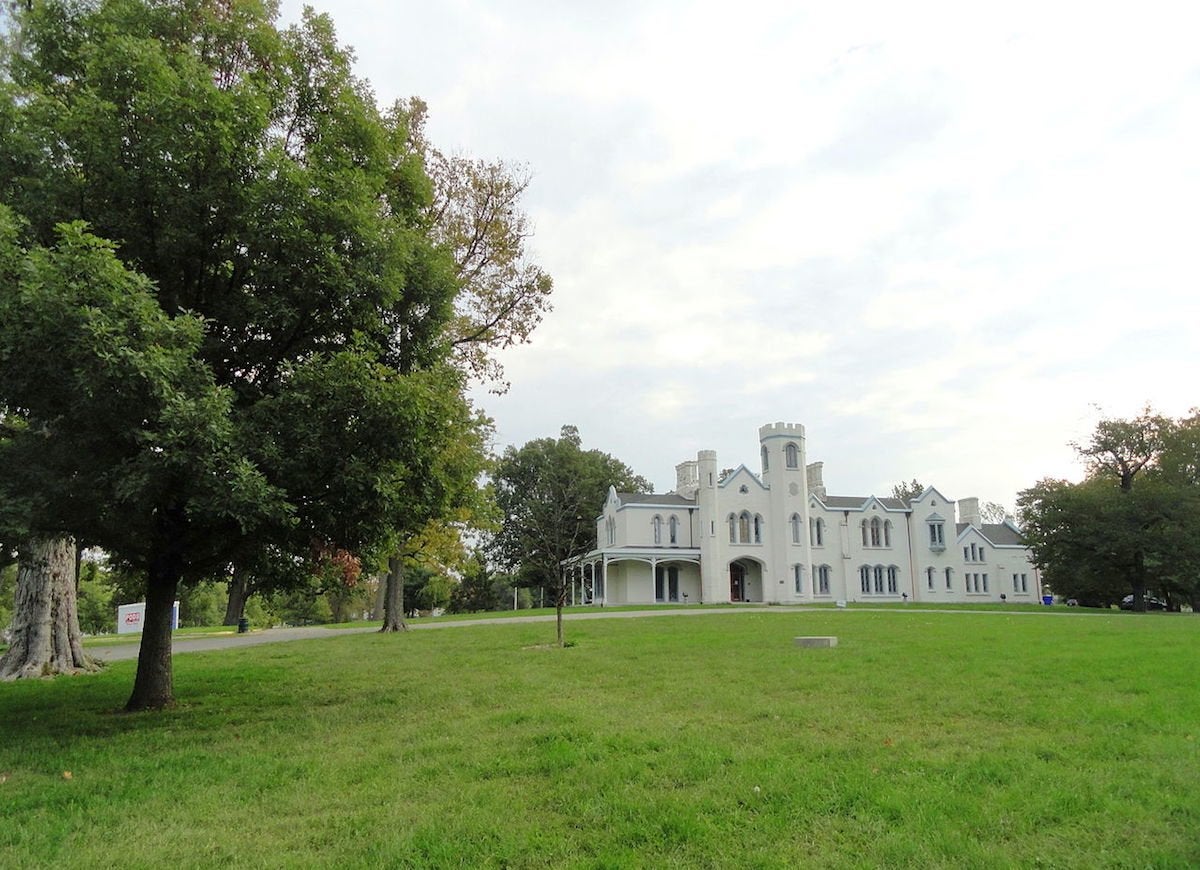
Wikimedia Commons via Daderot
The imposing tower topped with battlements and the narrow, diamond-paned windows are hallmarks of the Gothic Revival style, the inspiration for this hauntingly beautiful residence built by John McMurtry in 1850 and designed by Alexander Jackson Davis. The peculiar pad, which includes such features as a half-tunnel and a gymnasium, changed hands many times during its long history. It was built for Francis Key Hunt, then owned by Republican National Committee Chairman Colonel William Cassius Goodloe, and ended up with the city of Lexington. Today, the house is part of Castle Park and hosts the Lexington Art League. Tours are offered Tuesday through Friday as well as Saturday and Sunday during exhibitions.
Louisiana – Hermann-Grima House Museum
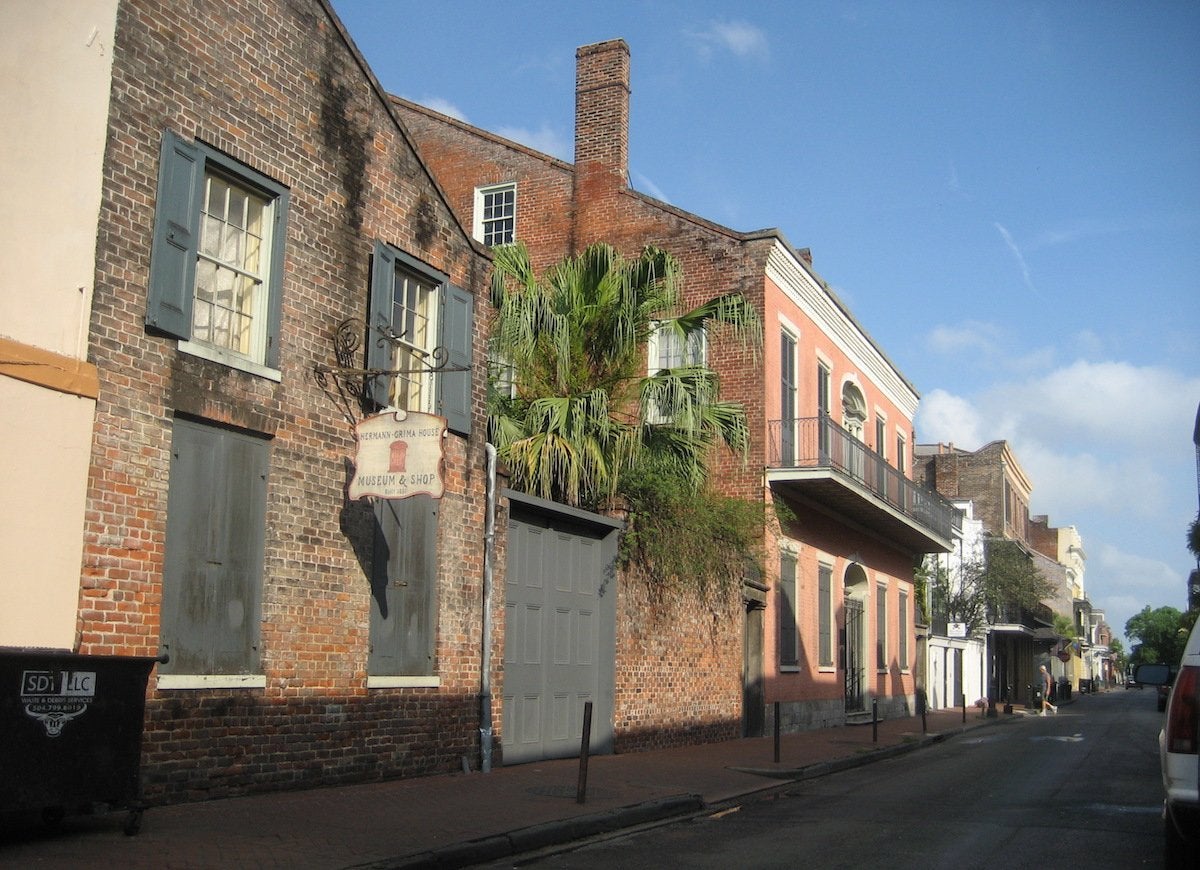
Wikimedia Commons via Infrogmation of New Orleans
Kathy Bates’s terrifying turn as real-life serial murderess Delphine LaLaurie in Season 3 of “American Horror Story” gave the country the chills. Did you know that portions of that lurid story were filmed in this grand home in the French Quarter of New Orleans? The Federal-style home, built in 1831 for Samuel Hermann and later sold to Judge Felix Grima, features a courtyard garden, a stable, and a kitchen with an open hearth. Although this house was not the site of LaLaurie’s dastardly deeds (her actual home was burned by a mob after her departure and subsequently rebuilt), there are apparently enough ghosts still in residence for it to be a stop on one of many New Orleans ghost tours. For those not interested in the paranormal, a straightforward visit is $15.
Maine – Olson House
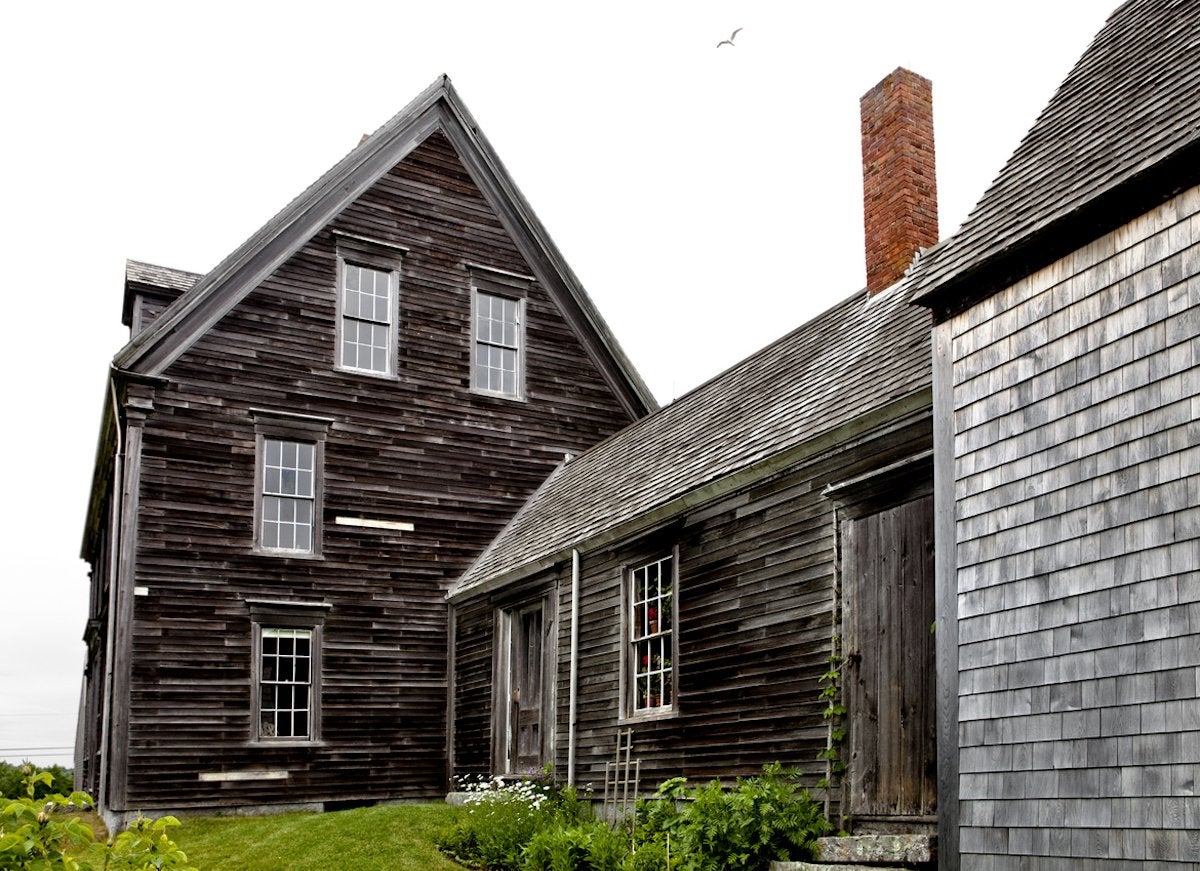
In Andrew Wyeth’s painting “Christina’s World,” a girl in pink sits in a grassy field with her eyes fixed on a distant farmhouse on a hill. The object of Christina’s gaze is this former home of Wyeth’s neighbors, siblings Christina and Alvaro Olson. The farmhouse was built in Cushing in the late 1700s by Captain Samuel Hathorn II and was extensively altered in later years by his descendants. The Olsons let Wyeth roam the residence, and the artist even used an upstairs room as his studio. Visitors can trod in Wyeth’s footsteps during a house tour for $15.
Maryland – Paca House
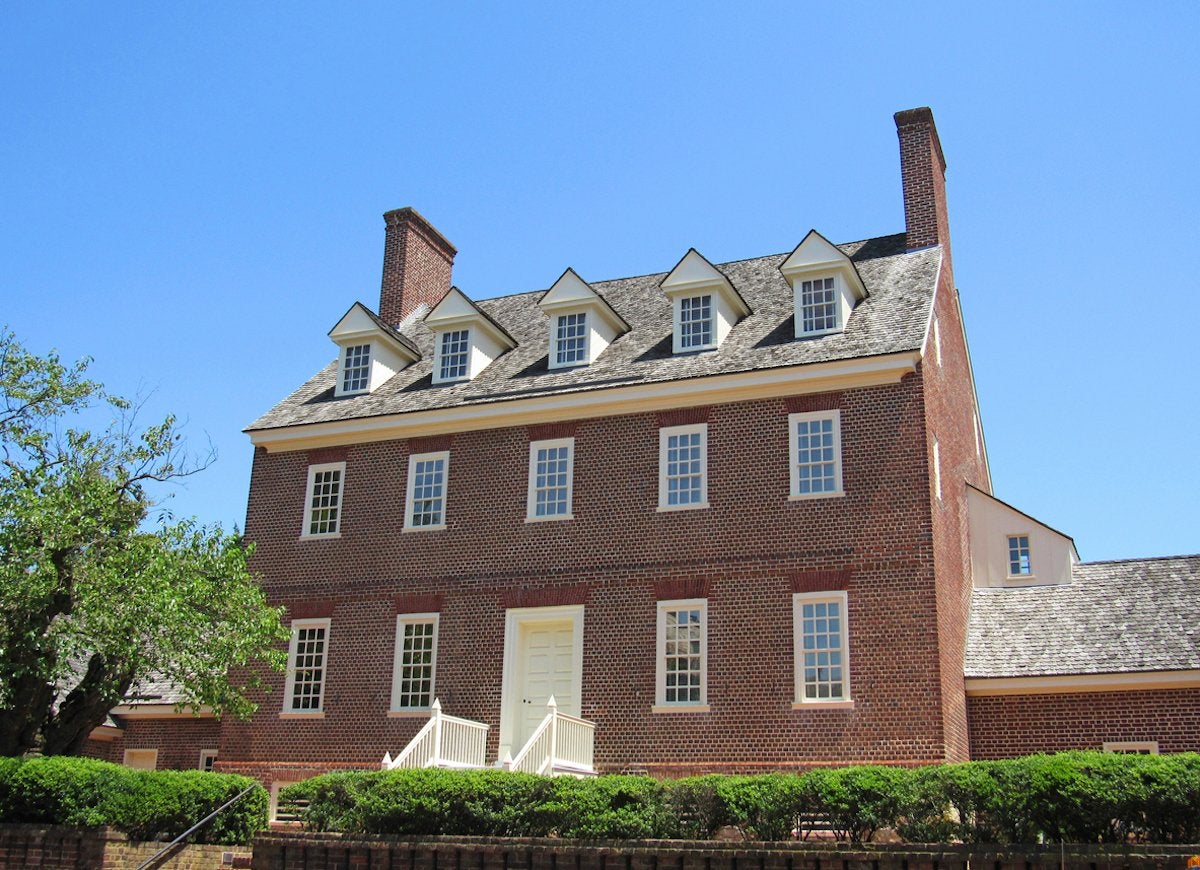
A true Renaissance man, three-time Maryland governor and signer of the Declaration of Independence William Paca also designed his own house. The results were rather extraordinary for one who was not an architect by trade. His legacy, the Georgian mansion that he built in Annapolis in 1763, beckons visitors to stroll its regal garden that features a fish-shaped pond and explore its rooms adorned with period furnishings and intricate woodwork, including a Chinese Chippendale-style balustrade. Tours are offered daily for $10; closed January through early March.
Massachusetts – The Paper House
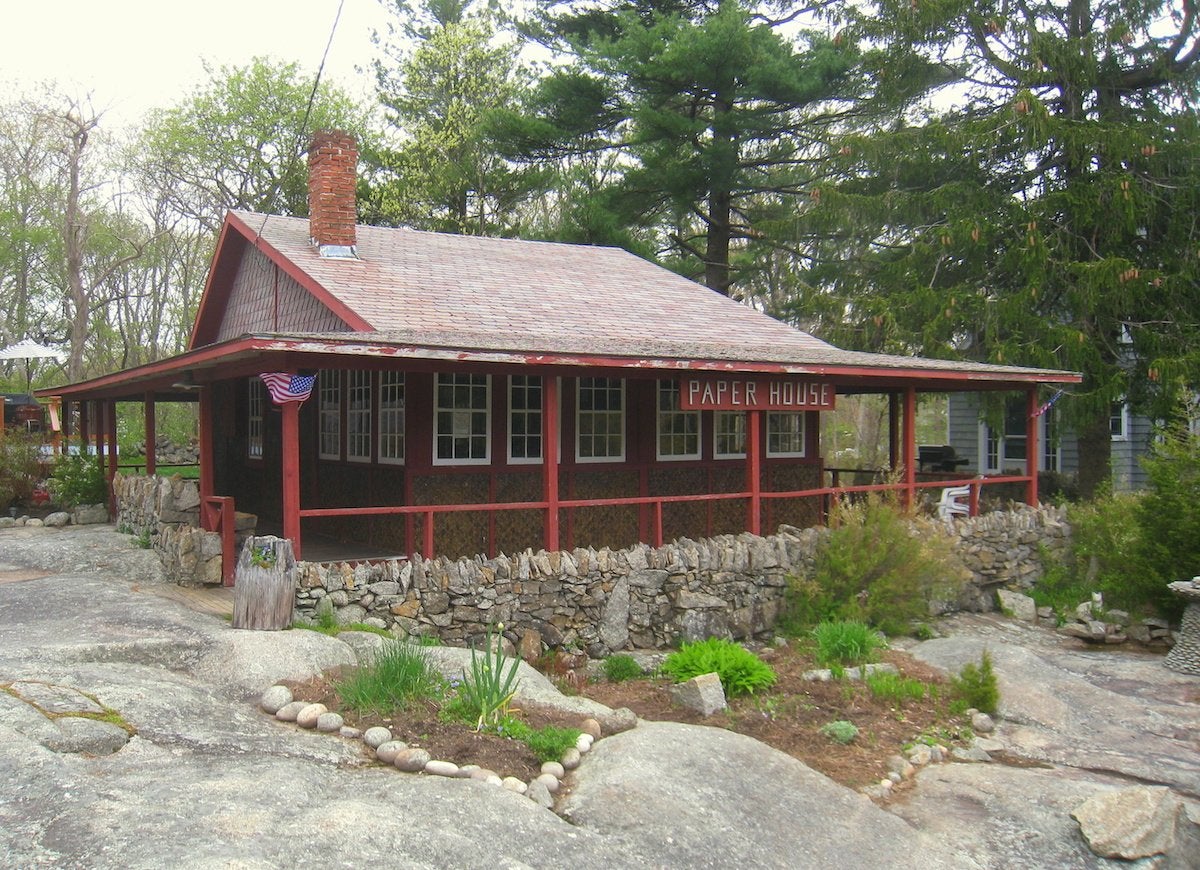
Wikimedia Commons via Daderot
Paper was evidently a passion of mechanical engineer Elis F. Stenman. Not only did he dream up the device that makes paper clips, but in 1922 he began building a summer home in Rockport out of paper—specifically newspaper. Paper doesn’t grace just the walls of the house, but also the furniture and other decor. On a tour of the unbelievable estate, offered every day from spring through fall for only $2, examine rarities like a piano covered in rolls of paper and a writing desk made from accounts of Charles Lindbergh’s flight.
Michigan – Alden B. Dow Home & Studio
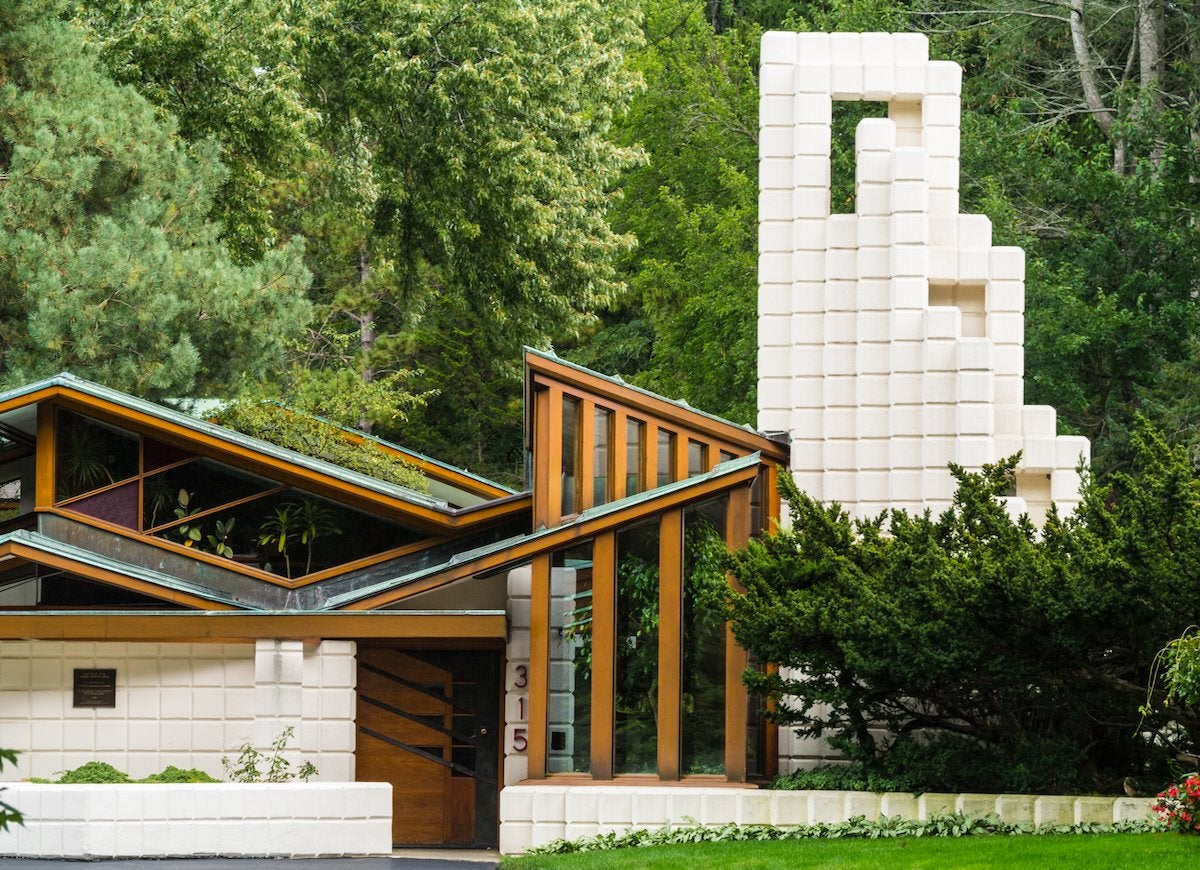
Wikimedia Commons via O. David Redwine
Architect Alden B. Dow once said, “Gardens never end and buildings never begin.” Fittingly, his midcentury modern home, completed in 1941, provides a refreshing departure from the urban landscape, with a copper roof that slopes down toward a tranquil pond, a sunken conference room that sits below water level, and walls of windows that immerse visitors in the outdoors. Visit the site to experience the dramatic geometry and organic sensitivity for yourself. Tours by reservation only, Monday through Saturday, for $15.
Minnesota – James J. Hill House
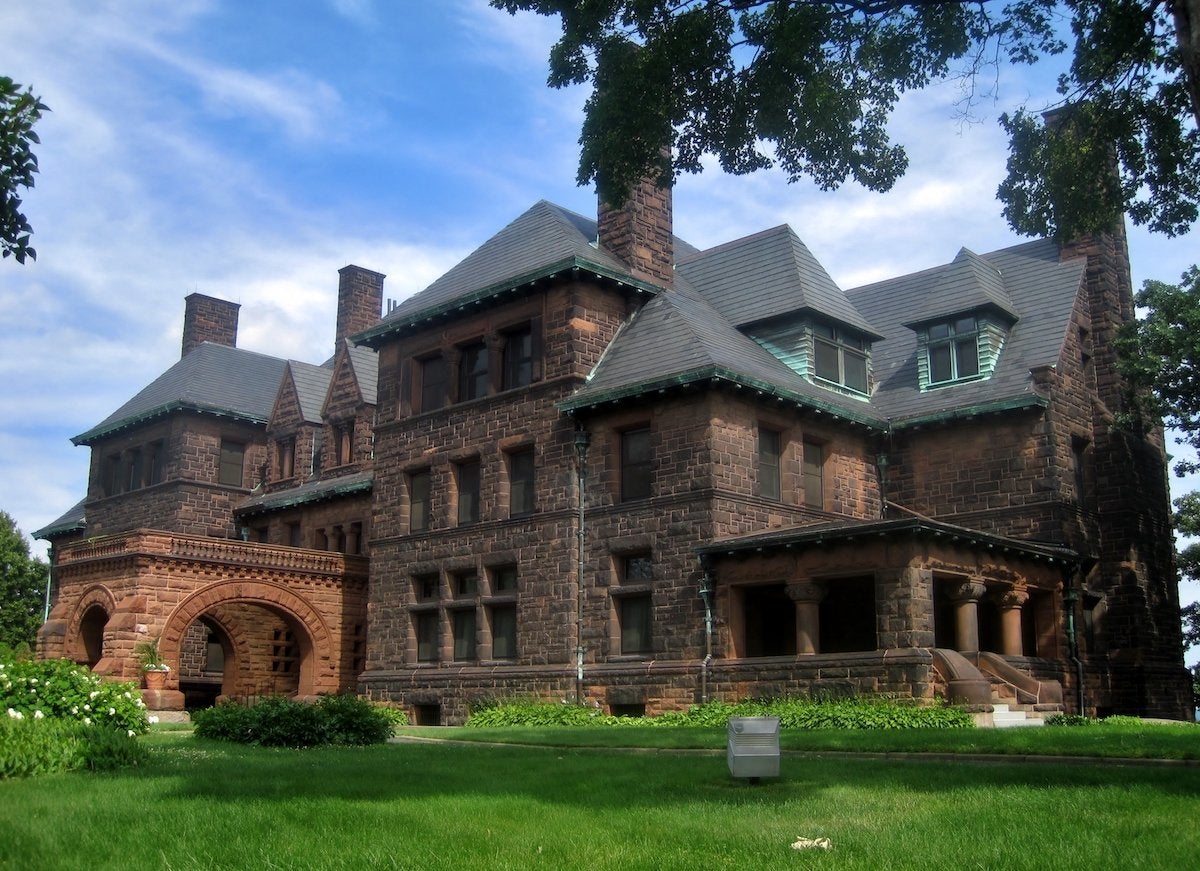
Wikimedia Commons via Teemu008
Billed as “Minnesota’s Downton Abbey,” this 36,000-square-foot Saint Paul mansion, built in 1891, was formerly home to railroad magnate James J. Hill and his family. Befitting a Gilded Age estate, no expense was spared. With a final cost of roughly $931,000, the five-story Richardsonian Romanesque mansion features 66 chandeliers, an 88-foot-long reception hall, and a three-story pipe organ. The museum offers a range of tours, including self-guided tours on Sundays in May through September ($10), a guided tour ($10), a “Nooks & Crannies” tour of seldom-seen corners of the house (June through August; $18), and a free tour for people with memory loss and their caregivers, available by reservation on the first Tuesday of every month.
Mississippi – Longwood
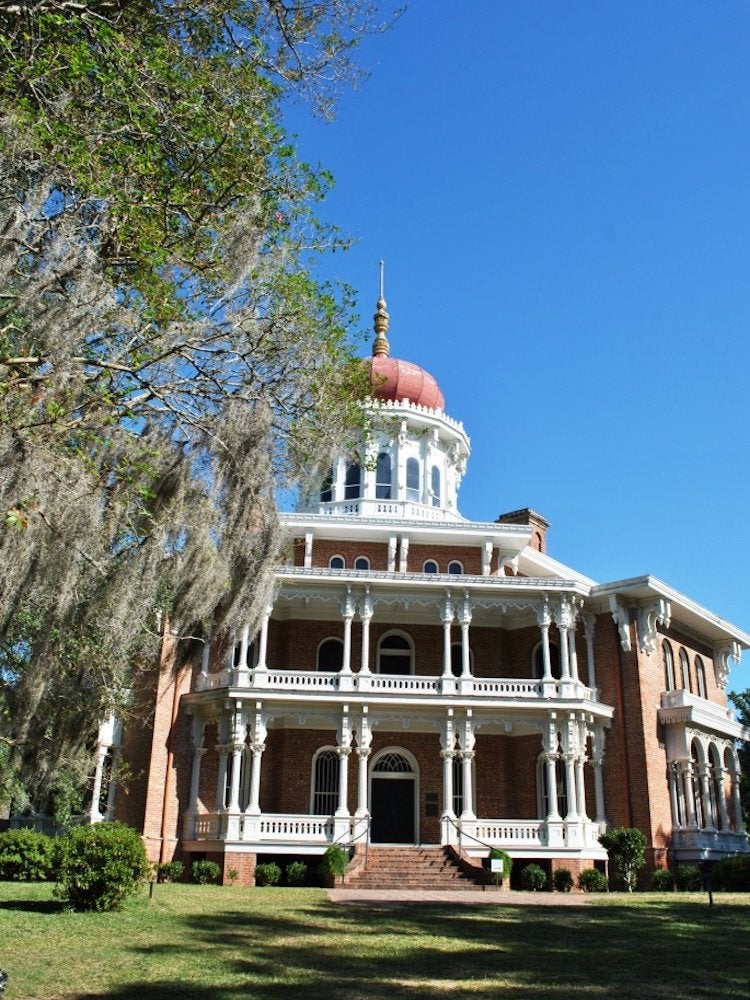
Wikimedia Commons via Elisa.rolle
Cotton planter Haller and Julia Nutt couldn’t have picked a worse time to start building their new home, opting to break ground in Natchez in 1860, on the eve of the Civil War. When war broke out, construction stopped. Only nine of the planned 32 rooms of the aptly nicknamed “Nutt’s Folly” were finished, and all of those were on the basement level. Haller himself died of pneumonia before the war ended, and the home was never completed. Yet the Nutts’ legacy lives on in their unfinished octagonal home, which has been a National Historic Landmark since 1971. Visit the never-to-be-completed home, still littered with abandoned tools and building materials, year-round for $25.
Missouri – Jesse James Home
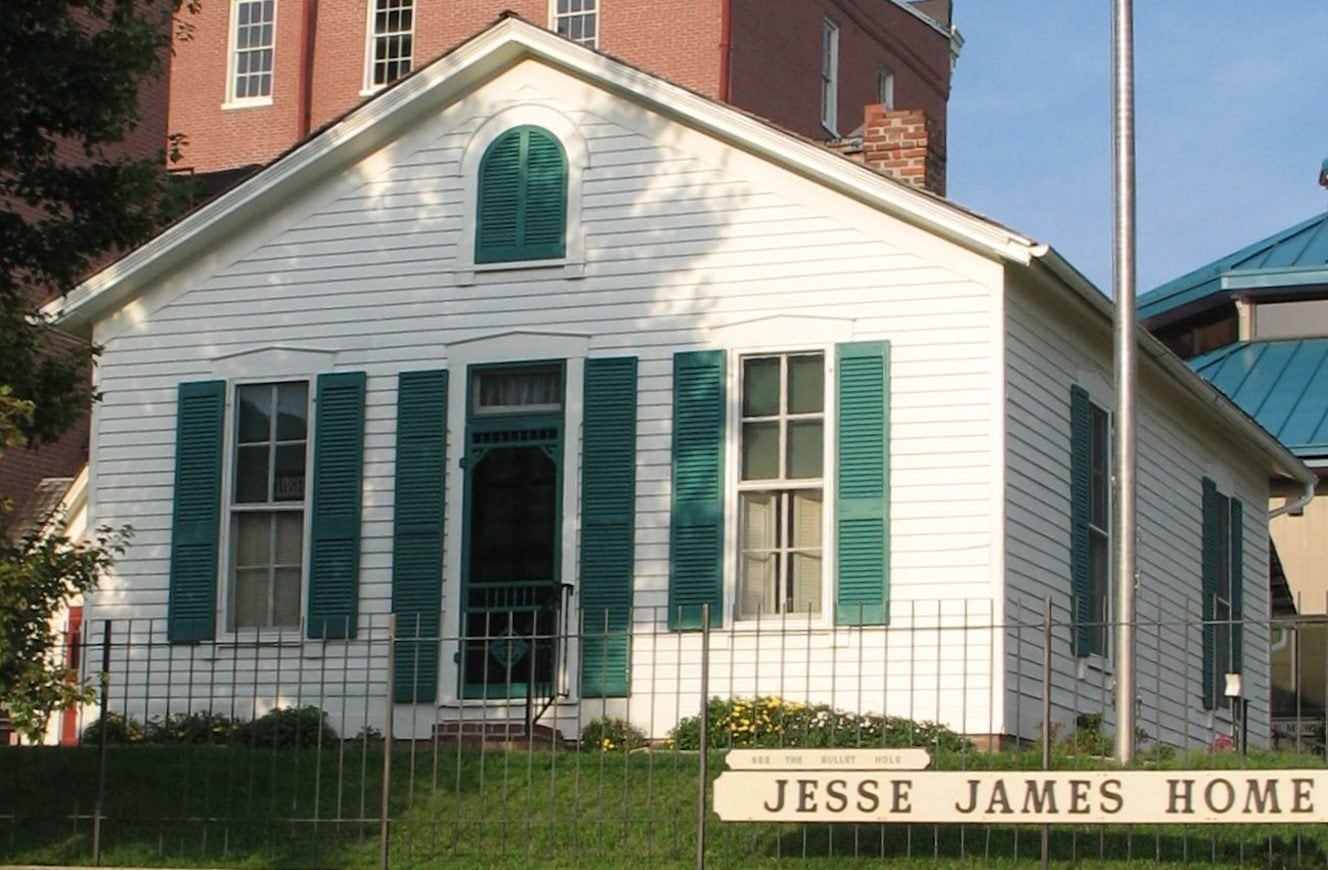
It was 1822 and just another day in the wild Midwest when outlaw Robert Ford shot and killed his gang’s leader, Jesse James, in this Greek Revival house in St. Joseph to nab the $10,000 reward offered by Governor Tom Crittenden. Although the house was moved from Lafayette Street to the Belt Highway in 1939, and then in 1977 to 12th and Mitchell, two blocks from its original location, it has been carefully preserved. In fact, the north wall still bears a bullet hole. For $4, you can tour the house museum and peruse artifacts related to James’s life and death.
Montana – Conrad Mansion
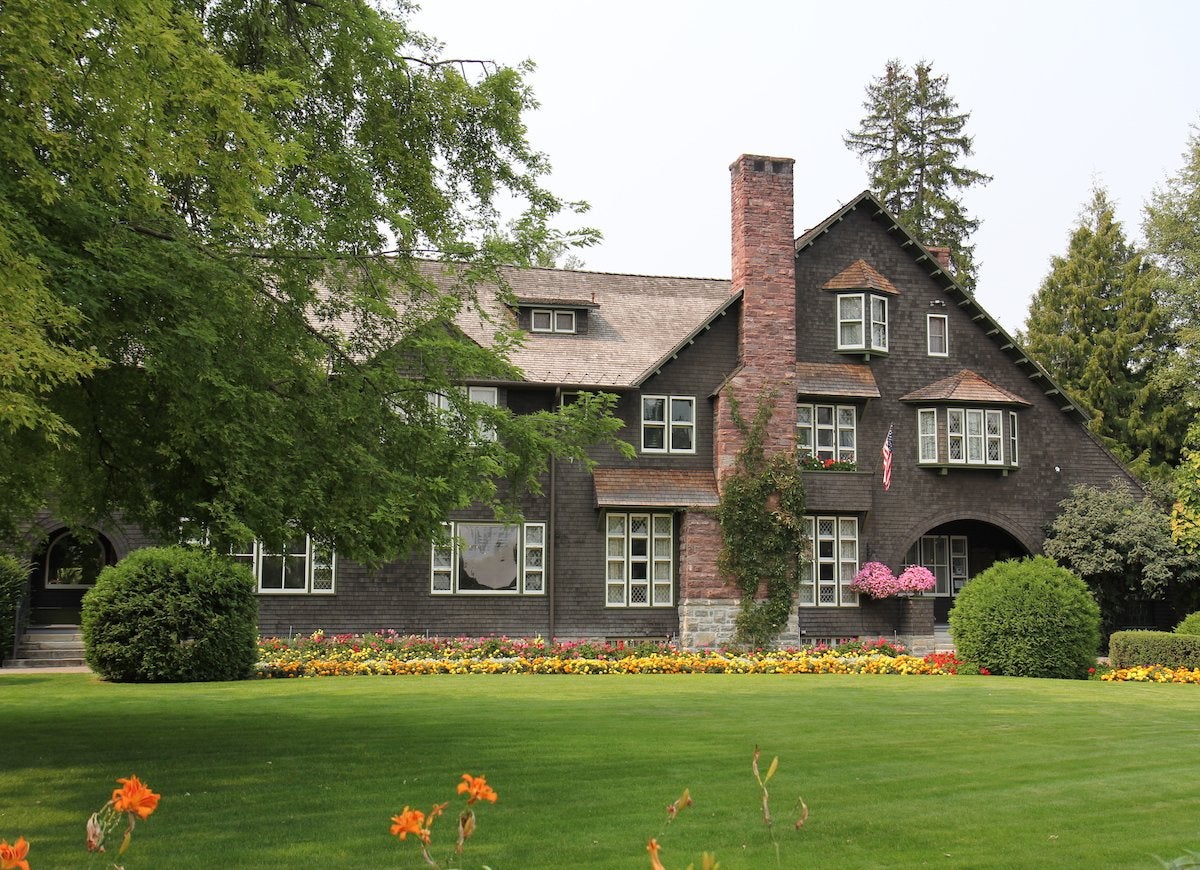
Wikimedia Commons via Royalbroil
Pioneer and Civil War veteran Charles E. Conrad moved his family into this mansion in Kalispell on Thanksgiving Day, 1895. The estate, which combines turn-of-the-century charm with technological innovations like a freight elevator and a new-fangled intercom system, is open for tours May through October and during the off-season, provided you contact them at least 24 hours in advance; tour price is $17.
Nebraska – Wildwood
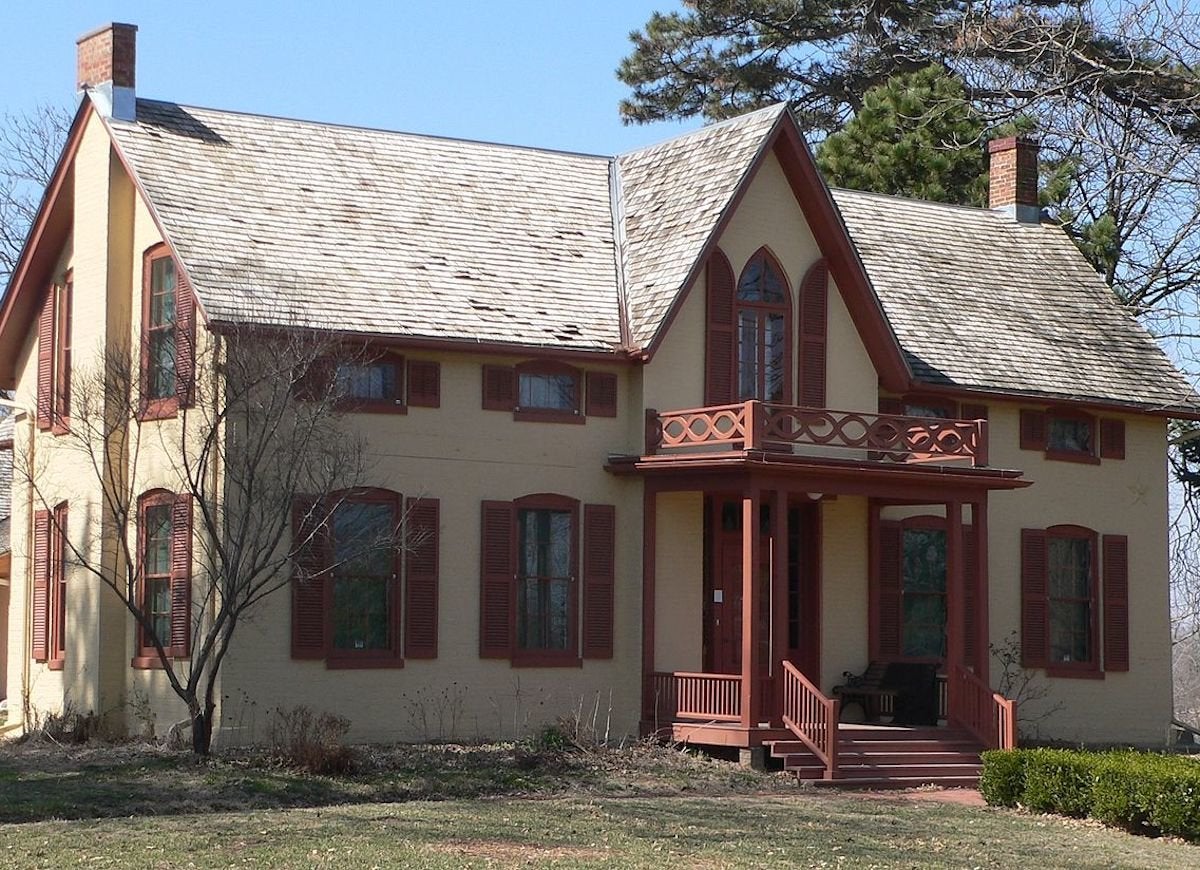
Wikimedia Commons via Ammodramus
A wealthy family and its country estate—the notion may sound peculiarly British, but the tradition exists in America too. Case in point: Wildwood, the charming Victorian Gothic Revival country home of the Ware family. This year the estate is celebrating its 150th anniversary with monthly events, including an Heirloom Christmas party. The property is open for tours daily from Arbor Day in late April through October as well as weekends in November; admission is $5.
Nevada – Thunderbird Lodge
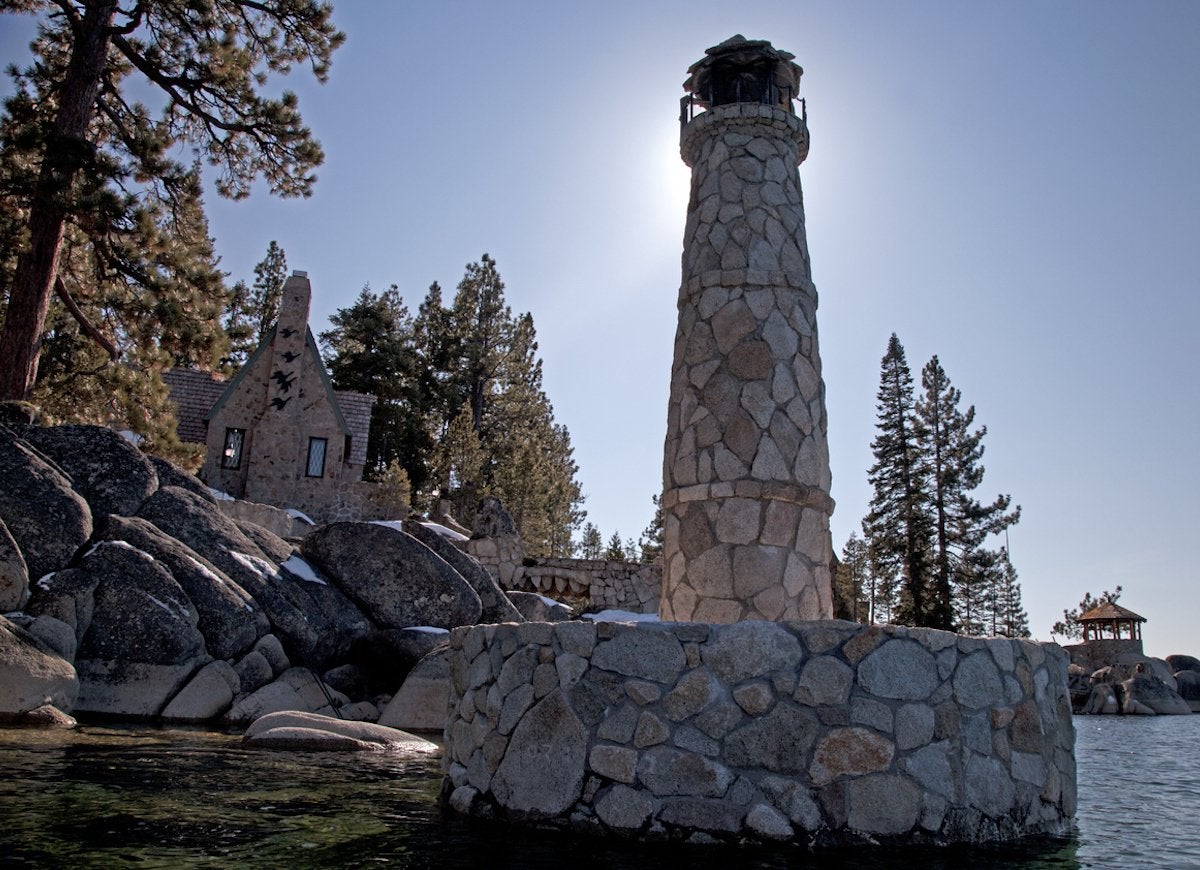
This National Historic Site on the edge of Lake Tahoe was once the home of George Whittell, Jr., who owned thousands of acres of Nevada shoreline in the early 1900s. The lodge is home to a vessel of the same name, the Thunderbird yacht, which has been in operation since the Great Depression. Tour Thunderbird Lodge from May through mid-October for $45, or enjoy one of the many other tours, water activities, or dining experiences offered by the lodge.
New Hampshire – Frost Farm
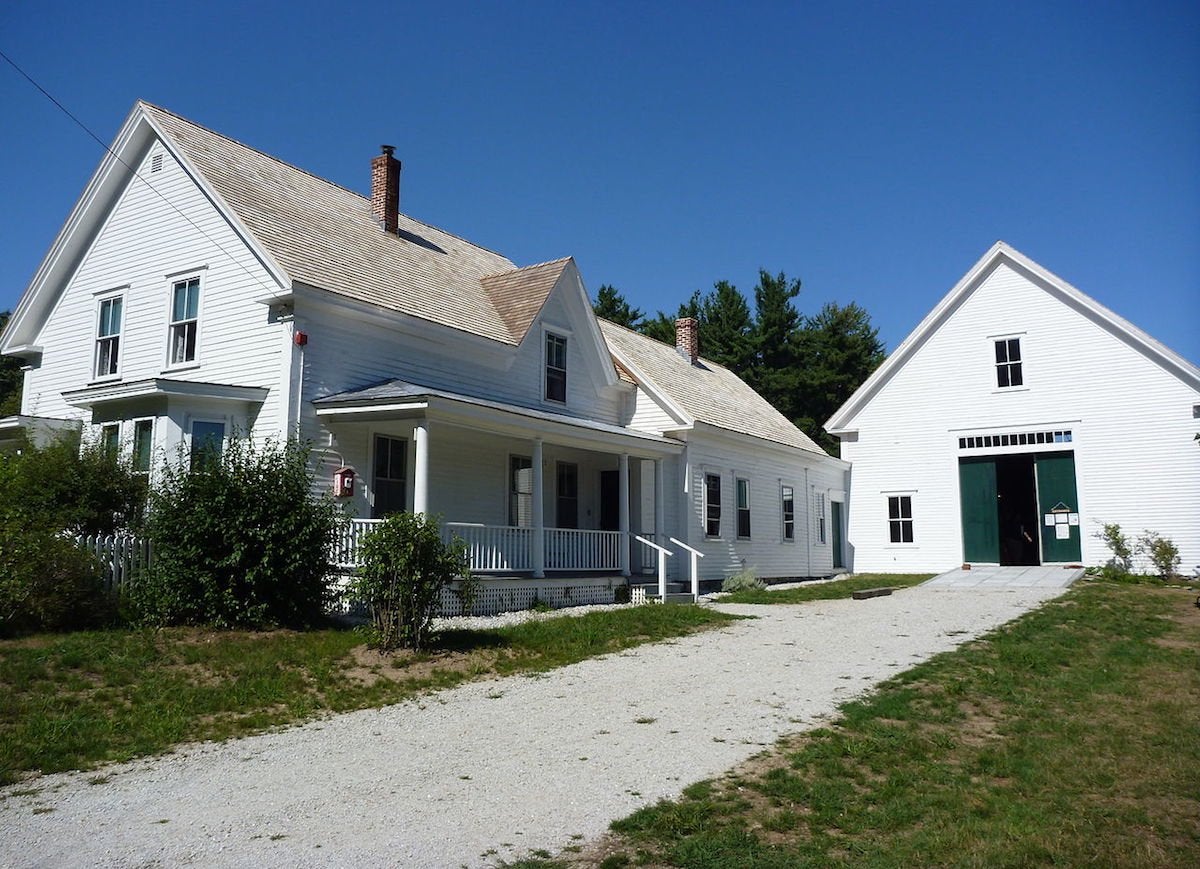
Wikimedia Commons via grongar
Robert Frost, one of our nation’s most beloved poets, owned this farm from 1900 to 1911. The site, now a New Hampshire State Park, stays true to its literary past with the Hyla Brook Reading Series and the Frost Farm Poetry Conference. The property attracts visitors from around the world and is open for tours from May through mid-October at the discretion of the Division of Parks and Recreation; admission is $5 ($4 for New Hampshire residents).
New Jersey – Drumthwacket
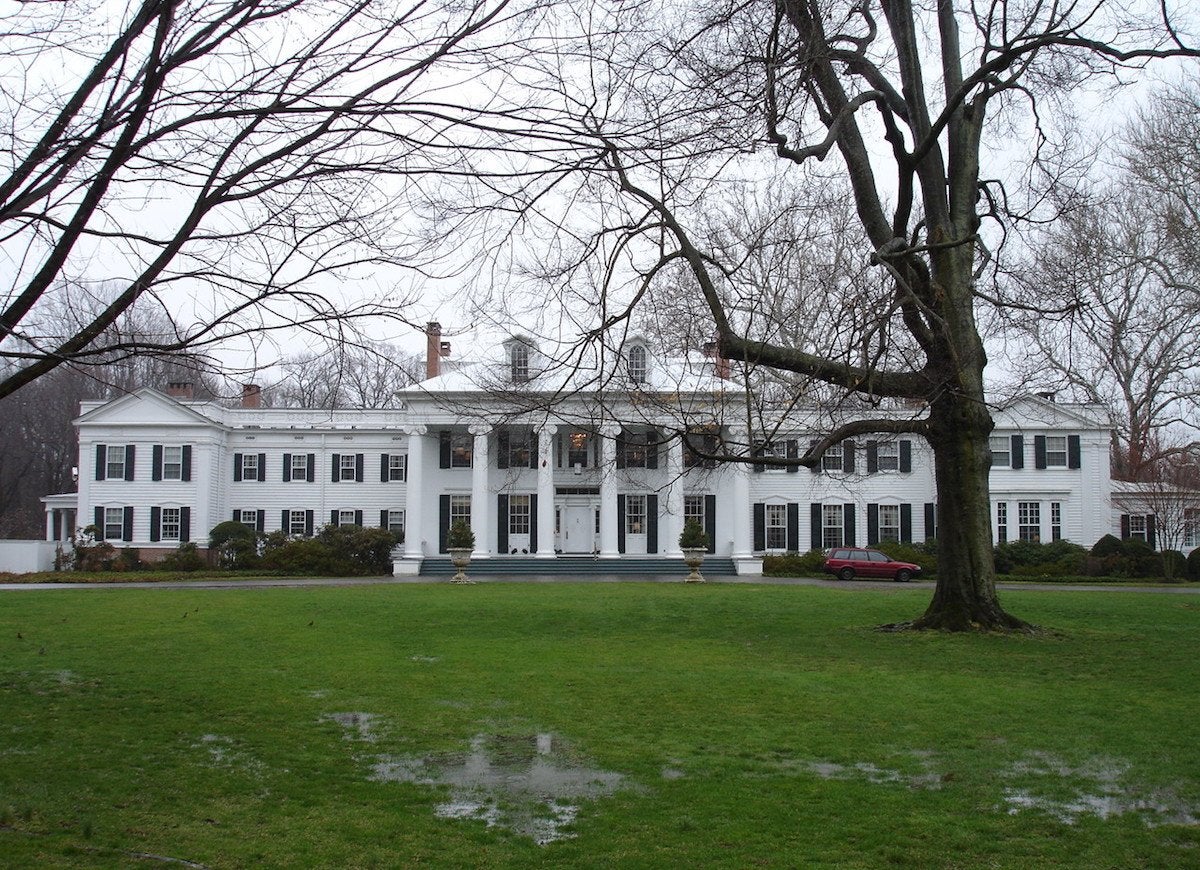
Wikimedia Commons via KForce
The name itself is reason enough to visit Drumthwacket, situated on land once owned by William Penn, the founder of Pennsylvania. This stately mansion, whose name comes from a Sir Walter Scott novel, today serves as a hands-on educational center, where visitors of all ages can learn about life in colonial America. Public tours are available for free on most Wednesdays (advance registration is required), and private tours and school visits are also offered.
New Mexico – Georgia O’Keeffe Home and Studio
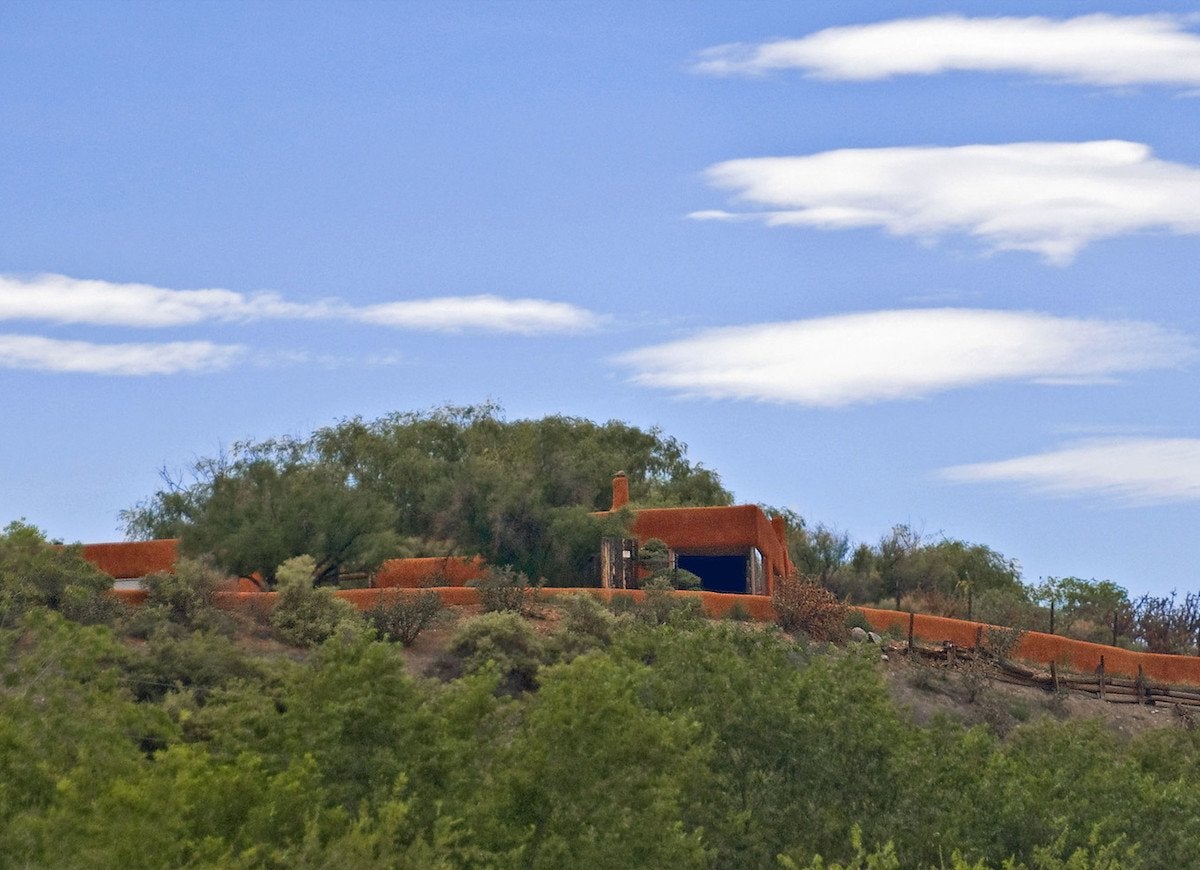
flickr.com via Ron Cogswell
Georgia O’Keeffe painted some of the most stunning and visionary images of the American landscape, and for those with an eye for the artistic, her home is no less inspiring. Explore the legacy of Georgia O’Keeffe by visiting her adobe home and studio in Abiquiú. Tours of the house that inspired more than two dozen paintings are available March through November; $40 per person.
New York – Alice Austen House
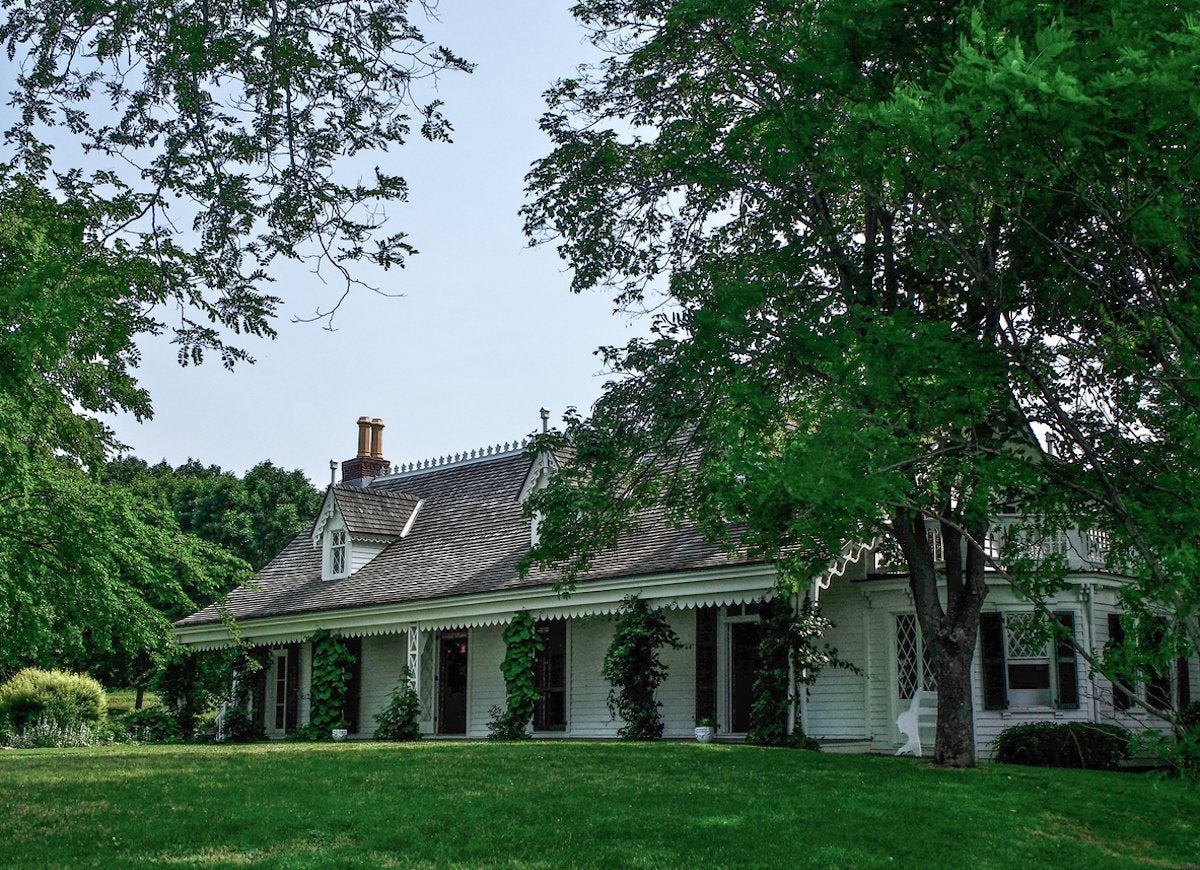
Alice Austen was a prolific, pioneering photographer of the late 19th and early 20th century. The home where she lived both as a child and later as an adult with her partner is now a stunning house museum celebrating her photography and her life. The house itself began life as a one-room Dutch farmhouse in 1690 but was extensively renovated over the years to become the Carpenter Gothic cottage that it is today. Open to the public daily, this National Historic Landmark is a testament to the determination of its history-loving neighbors, who saved the site from being converted into a high-rise development in the 1960s.
North Carolina – Biltmore Estate
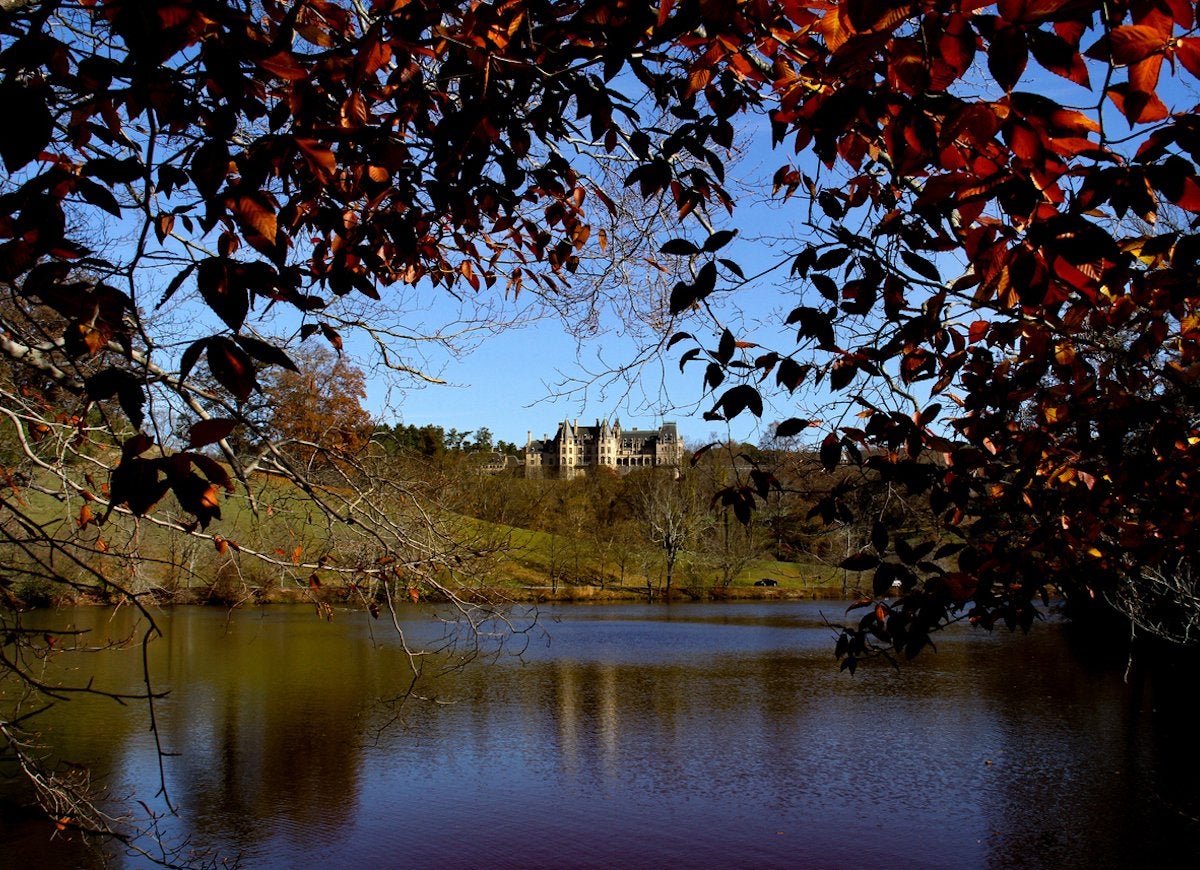
Biltmore is America’s answer to Europe’s castles and palaces. The largest private home in America, the 250-room estate was the home of George and Edith Vanderbilt, who made their fortune through railroads. The mansion and gardens are open to visitors daily, and a variety of tours are available; prices vary. Those who want to revel in the delights of the Gilded Age can even book a stay at the on-site cottage or surrounding properties.
North Dakota – Maltese Cross Cabin
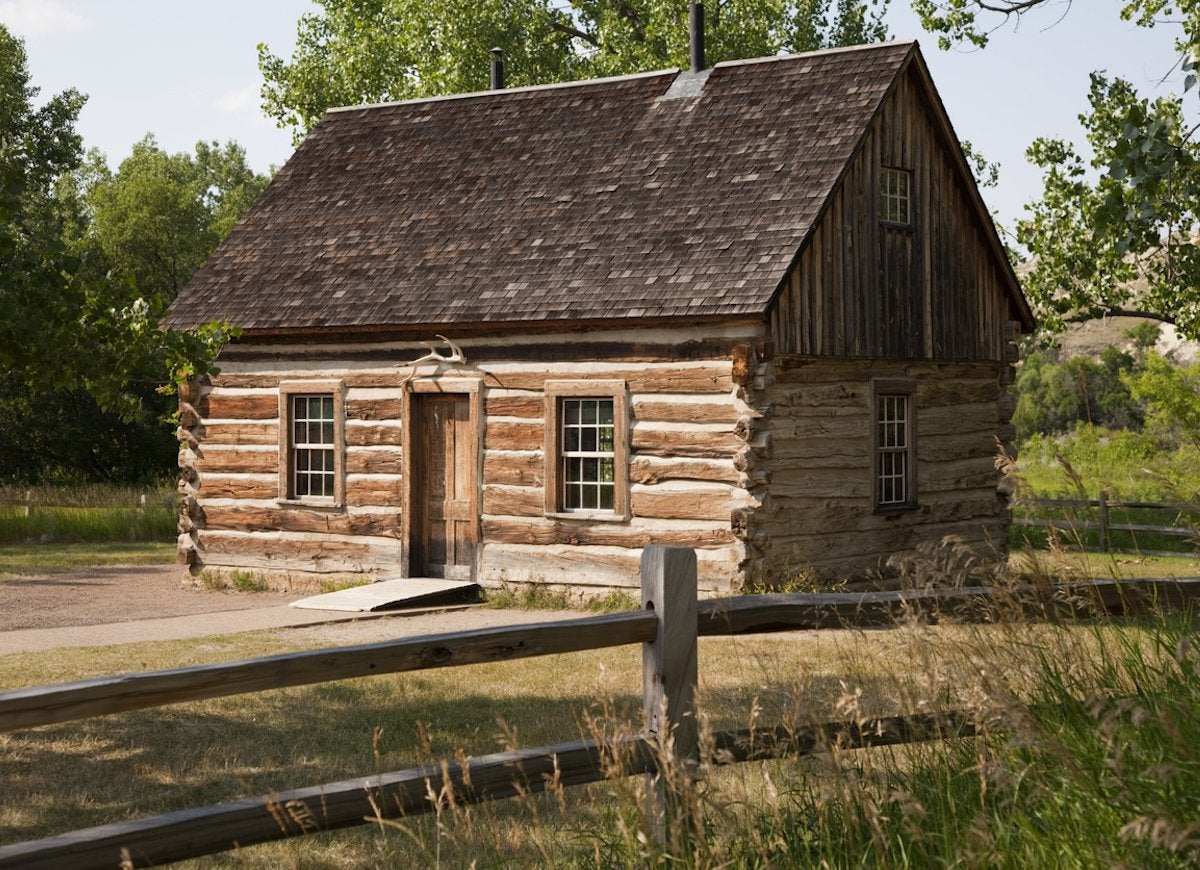
Home is where the heart is—and this is especially true of Theodore Roosevelt’s Maltese Cross Cabin, located on Chimney Butte Ranch. Before Roosevelt became our 26th president, he called this humble cabin his temporary home. It was here where he hunted bison and developed a love for America’s great outdoors. Although the cabin has been relocated and extensively restored since its first inhabitant departed, the log walls are original to the 1883 construction. During the Roosevelt administration, the National Park System grew by leaps and bounds, so it is fitting that the house now falls under their stewardship. Tour information is available at the NPS website.
Ohio – Hawthorn Hill
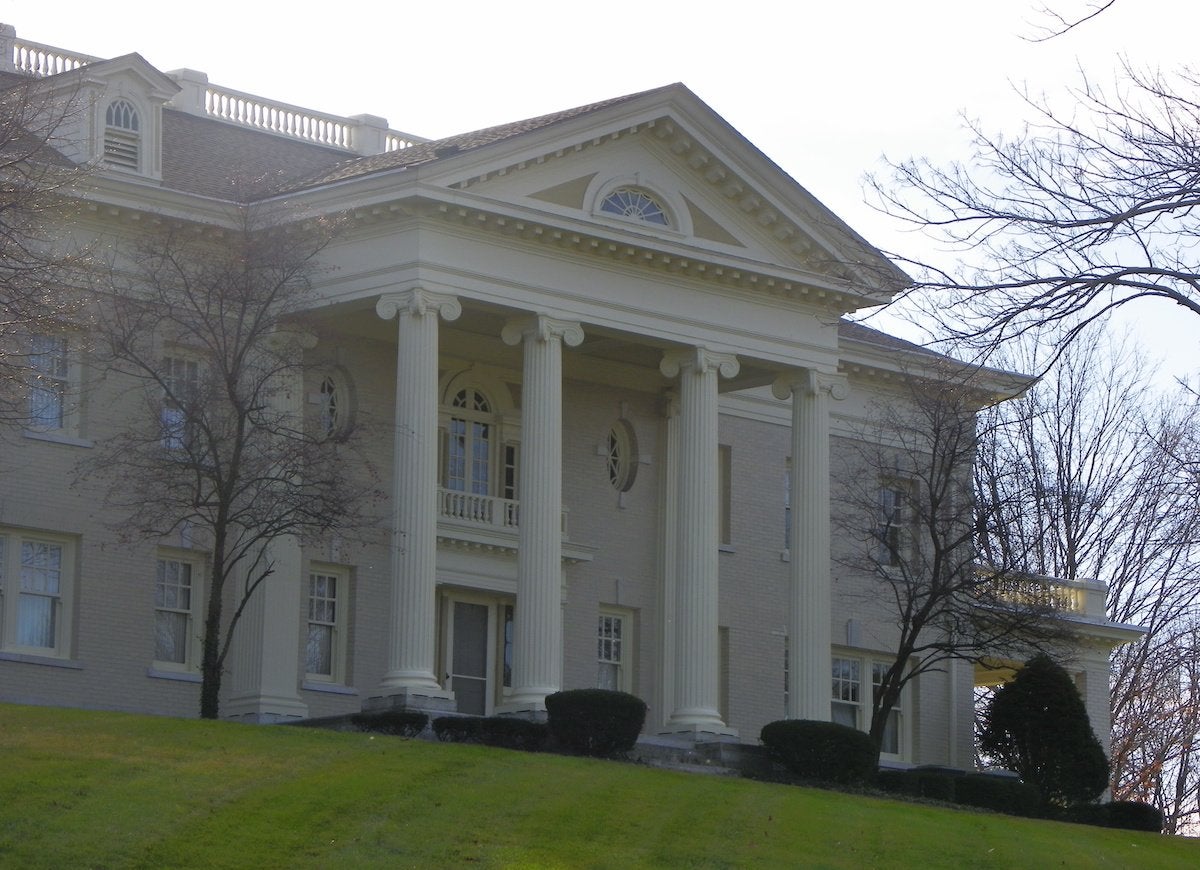
Wikimedia Commons via Zeist85
Hawthorn Hill in Oakwood was the last—and most lavish—home of Orville Wright. The pioneer of aviation opened the grand doors of his residence to many historic figures, including Thomas Edison and Henry Ford. The property is now affiliated with the 65-acre Carillon Historical Park, which celebrates Dayton’s contributions to our nation. Tours are offered every Wednesday and Saturday; $14 per person (advance prepaid admission required).
Oklahoma – Hunter’s Home
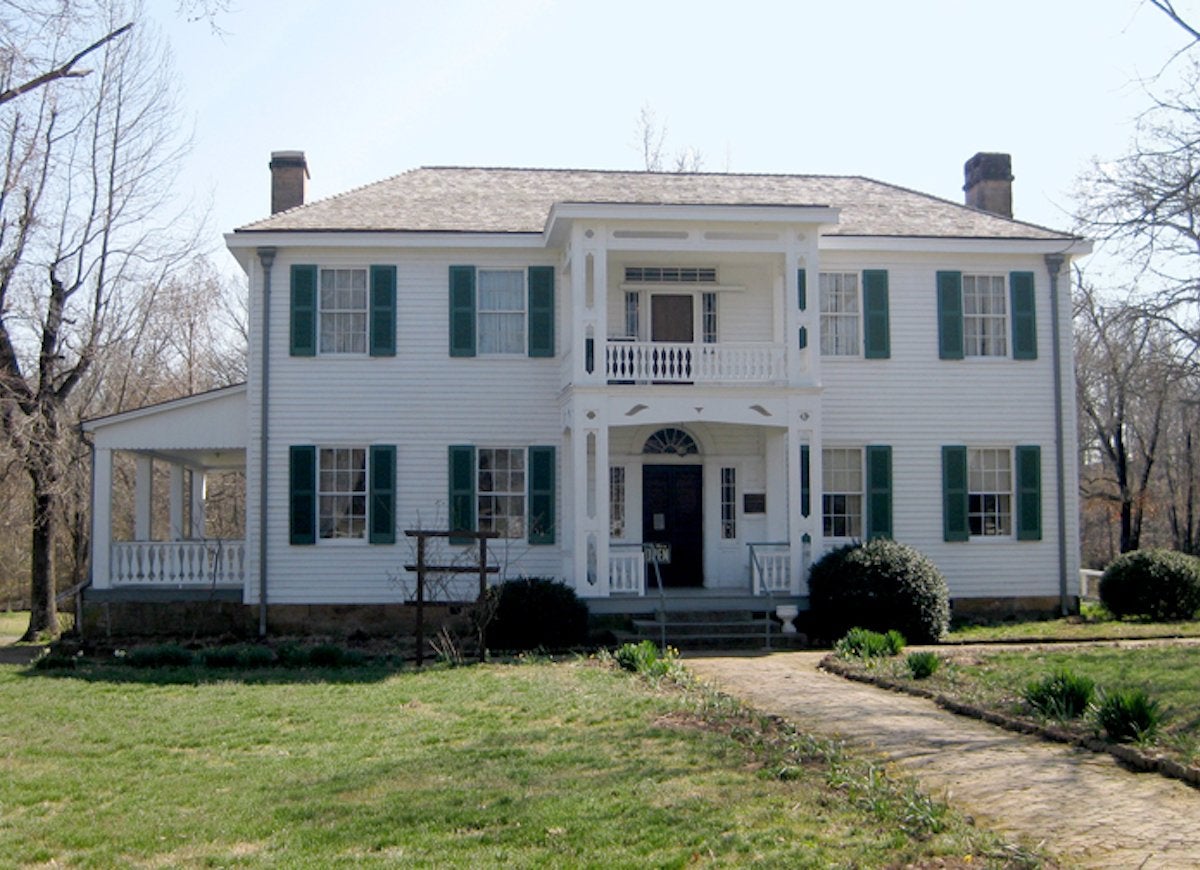
Wikimedia Commons via Uyvsdi
George Michael Murrell was married to Minerva Ross, a prominent Cherokee woman whose uncle, Chief John Ross, played a major role in American history. When the Cherokee were forced to leave their homes in the Southeast during the Trail of Tears in 1838, Murrell chose to move west with them, to the new Indian Territory. There, in 1845, he built his mansion, Hunter’s Home. Today the house, which is maintained with support from the Cherokee Nation, is open for interpretive tours Tuesday through Saturday from Labor Day through Memorial Day and at other times seasonally; admission is $7 per person.
Oregon – Pittock Mansion
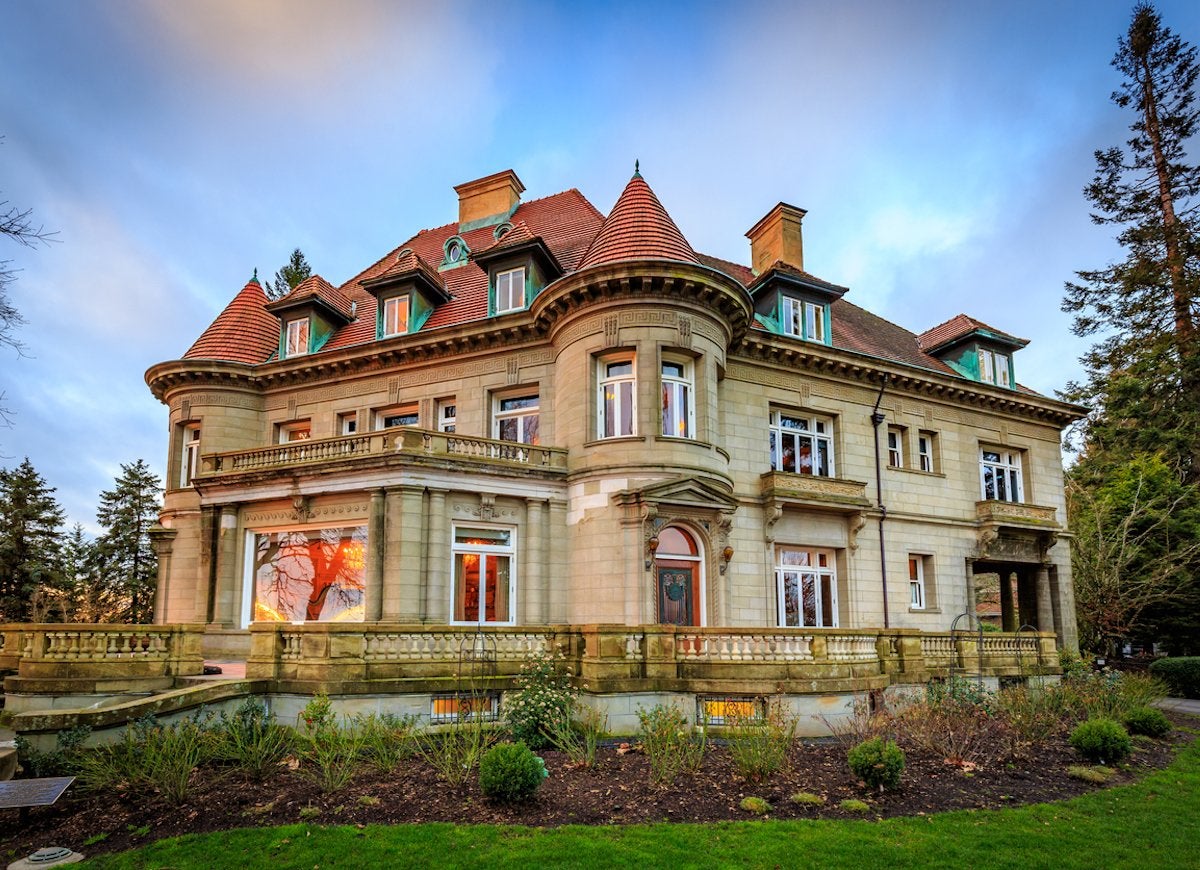
Henry Pittock, who traversed the Oregon Trail to seek his fortune then rose from typesetter to rich newspaperman, is an American success story. His home, Pittock Mansion, which was built in 1914, has its own rags-to-riches story: After it had sat empty for years and was seriously damaged in the Columbus Day Storm of 1962, there was talk of turning the site into a housing development—that is, until dedicated Portlanders rallied, purchasing and restoring the crumbling property. Now you can visit the home, which is now a museum of local history, daily from February through December (except major holidays); $12 per person.
Pennsylvania – Johnson House
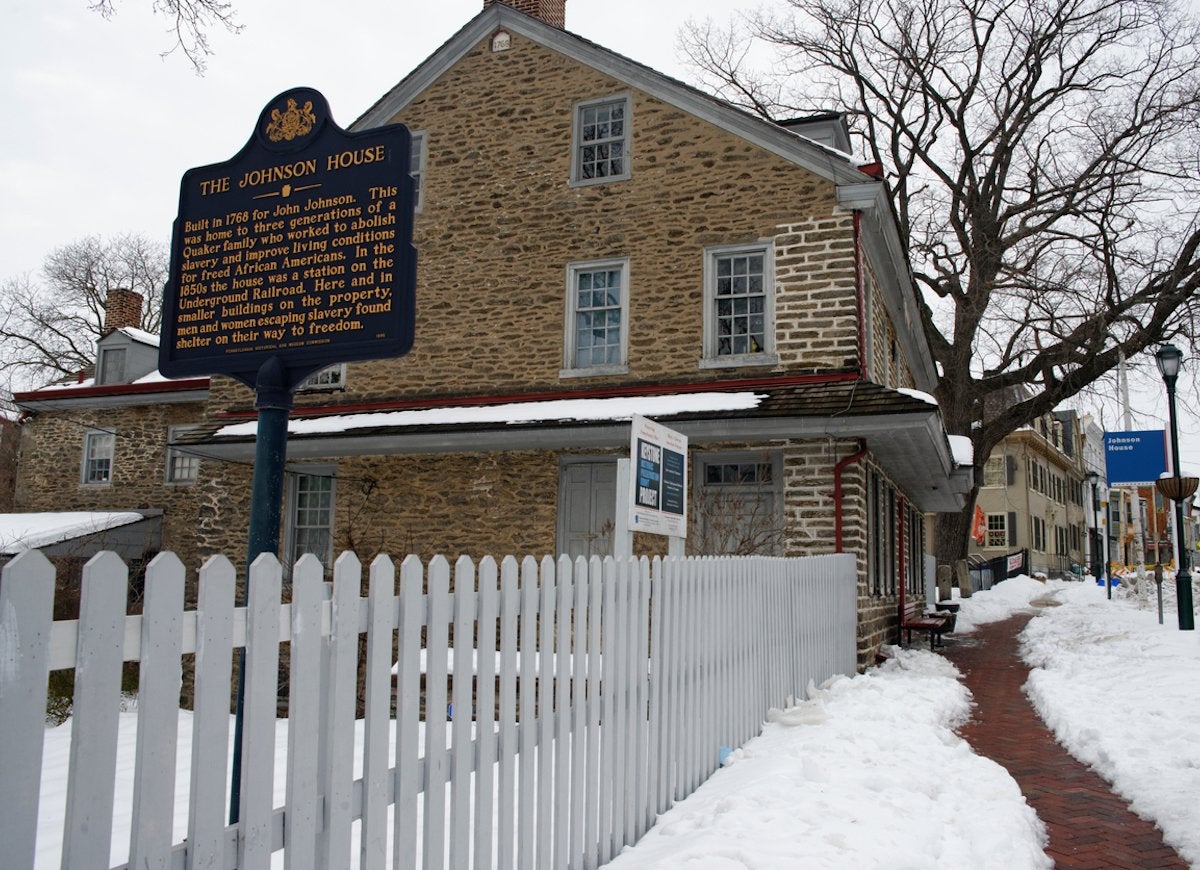
Why visit just one home when you can visit 18 historic houses? In Philadelphia’s Germantown neighborhood—also known as “Freedom’s Backyard”—you can revel in the moving stories of America’s Revolutionary past. Be sure to visit the Johnson House, one of the few remaining sites of the Underground Railroad. Hours of operation vary; passports available for individuals and families who plan to be frequent visitors.
Rhode Island – John Brown House
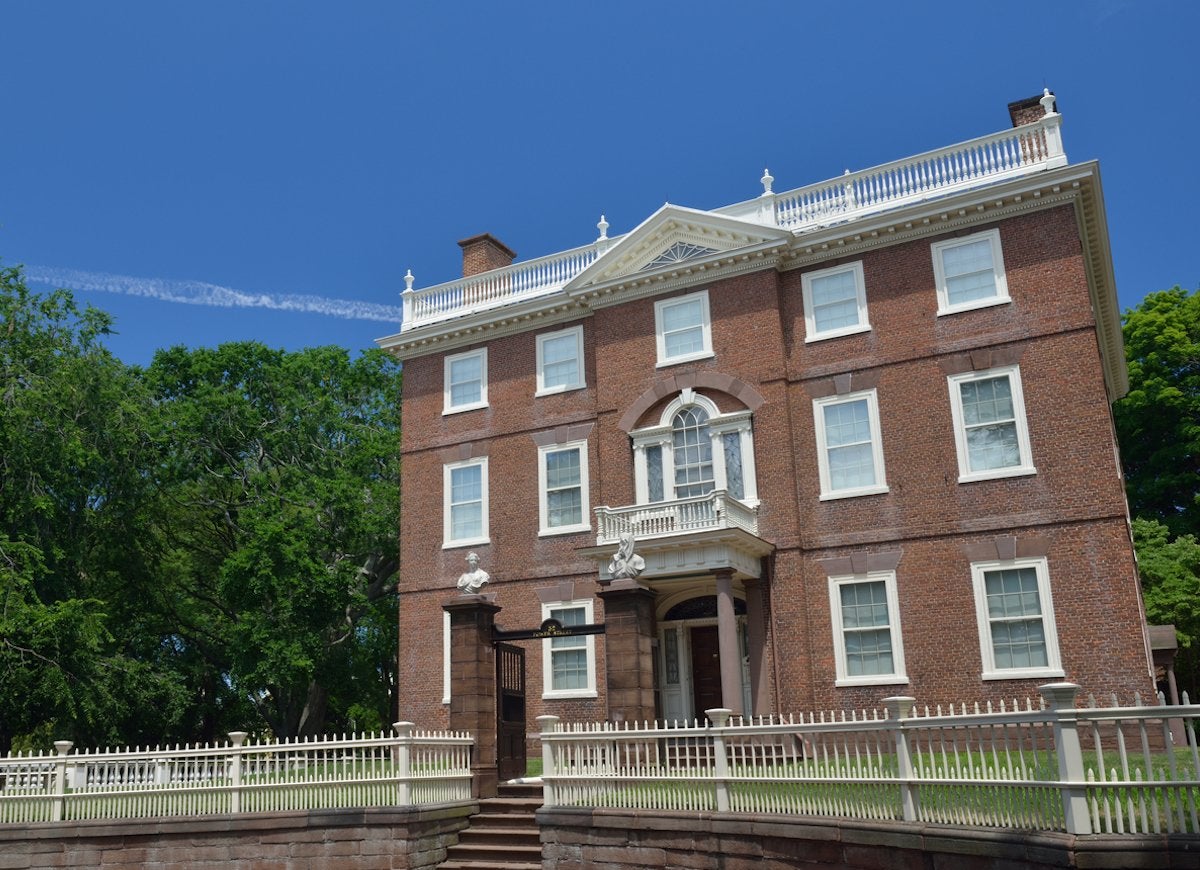
The most famous John Brown in U.S. history is no doubt the abolitionist and firebrand whose actions fanned the flames in the years leading up to the Civil War. But before him there was another famous man of the same name, a wealthy politician and slave trader whose surname graces Brown University. Learn more about the man at the John Brown House in Providence, built in 1788 and visited by such figures as George Washington and Abigail Adams. Guided tours touch on important issues of the day, such as slavery and the American Revolution, and are offered year-round ($10 per person), though days and hours vary seasonally.
South Carolina – Middleton Place
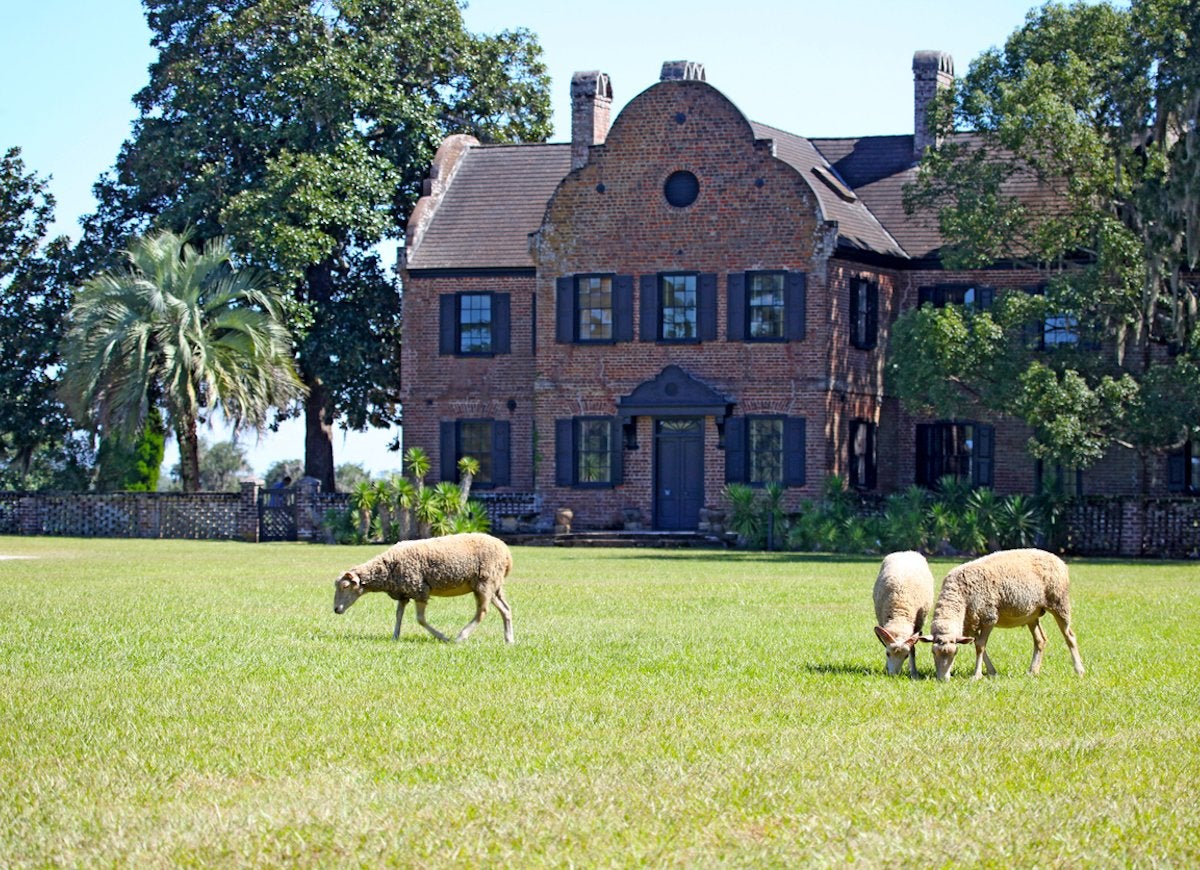
Home to the oldest landscaped gardens in America, Middleton Place has a rich and complicated history. It was built by enslaved men and women for the Middleton family of Charleston; Arthur Middleton, a son, was one of the signers of the Declaration of Independence. Today, the property includes the painstakingly restored house museum as well as the extensive gardens, stable yards, a restaurant, and shops. Tours are available daily, year-round; $29 per adult.
South Dakota – Laura Ingalls Wilder Historic Homes
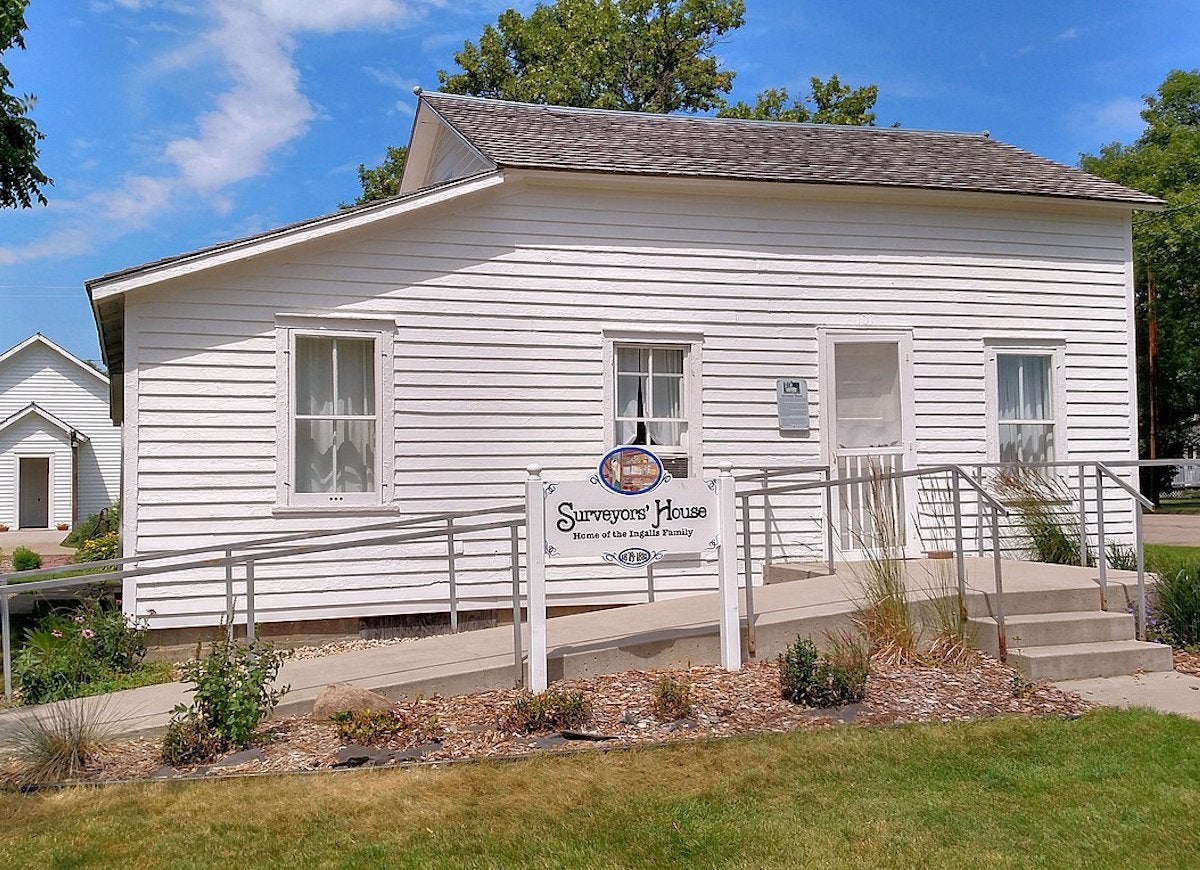
Wikimedia Commons via Winkelvi
Laura Ingalls Wilder, the quintessential pioneer girl and author of the ever-popular Little House on the Prairie series, was a real, flesh-and-blood woman, and you can visit her childhood homes in De Smet. You can also visit the first De Smet school, which Laura attended, as well as the gravesites of the Ingalls family. The properties are open for tours most days, although availability varies by season; $14 per adult.
Tennessee – Belmont
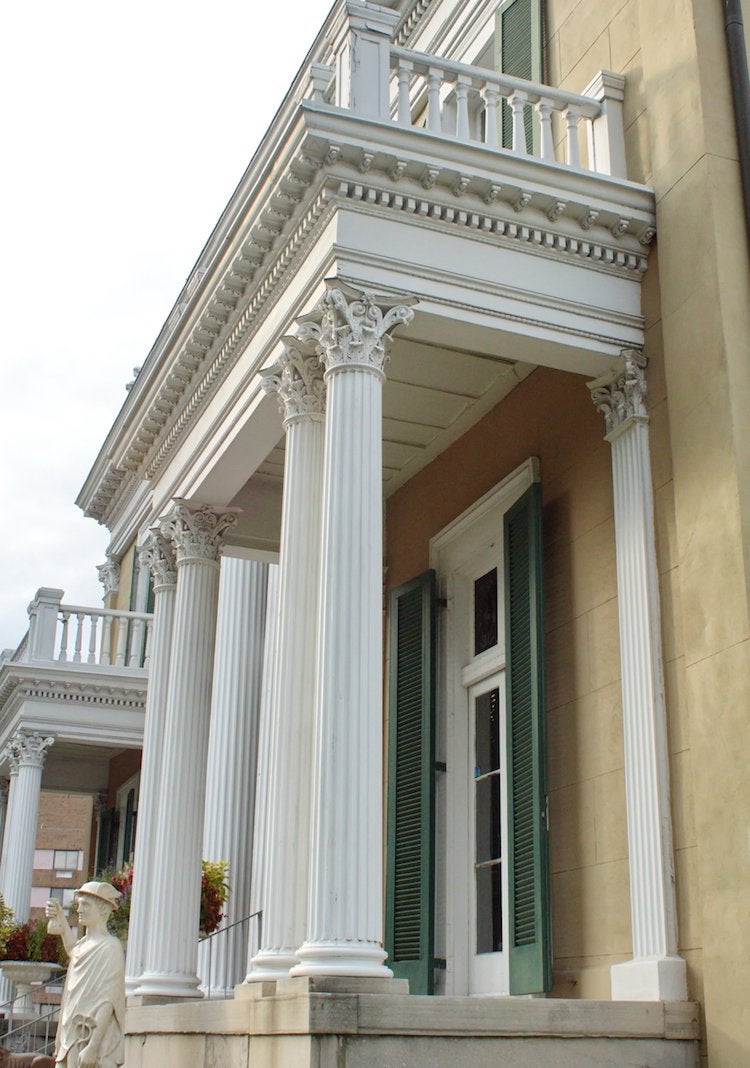
This winter, do Christmas in high style at Belmont, the Nashville mansion built in 1853 as the summer home of the extraordinarily wealthy plantation owner Adelicia Acklen and her second husband. The ornate Italianate villa is open for tours daily ($15 per adult), with specialty art, history, and garden tours available by reservation. Christmas, too, is full of special events, including breakfast with Santa.
Texas – Governor’s Mansion
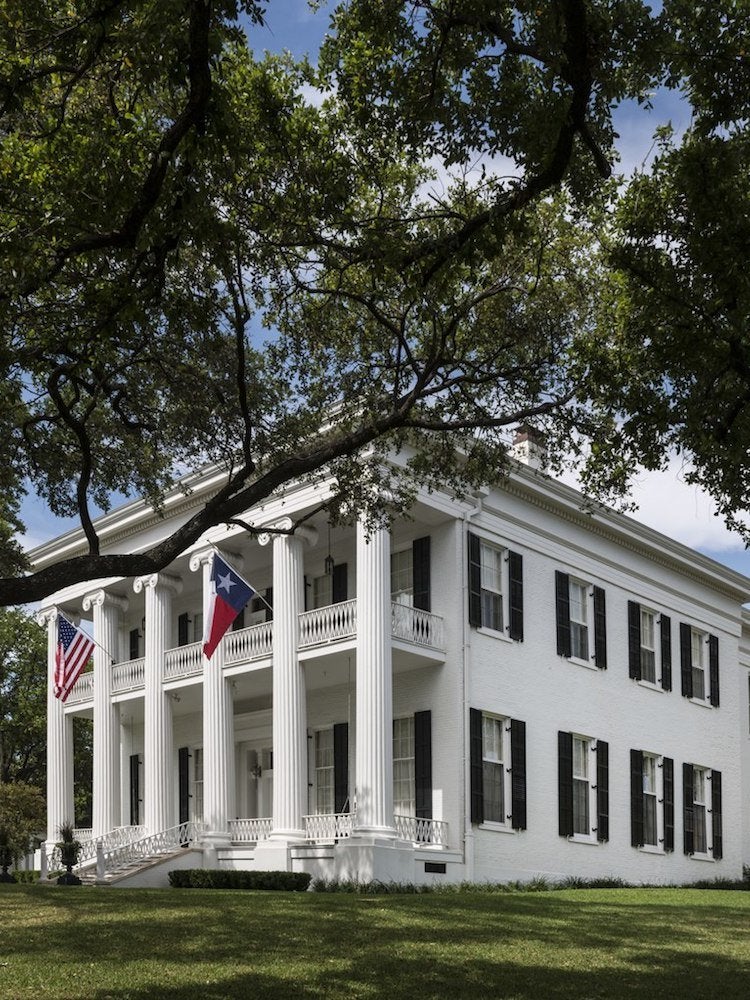
Wikimedia Commons via Library of Congress and Carol M. Highsmith
The Texas Governor’s Mansion, a spectacular Greek Revival edifice, was completed in 1856, which makes it older than the massive Texas State Capitol. In fact, it’s the oldest continuously occupied governor’s residence west of the Mississippi. But don’t be fooled by its age. The Governor’s Mansion has the latest in building technology and is seeking LEED certification as a green and energy-efficient building. Tours must be reserved in advance; dates are posted on the governor’s website.
Utah – Beehive House
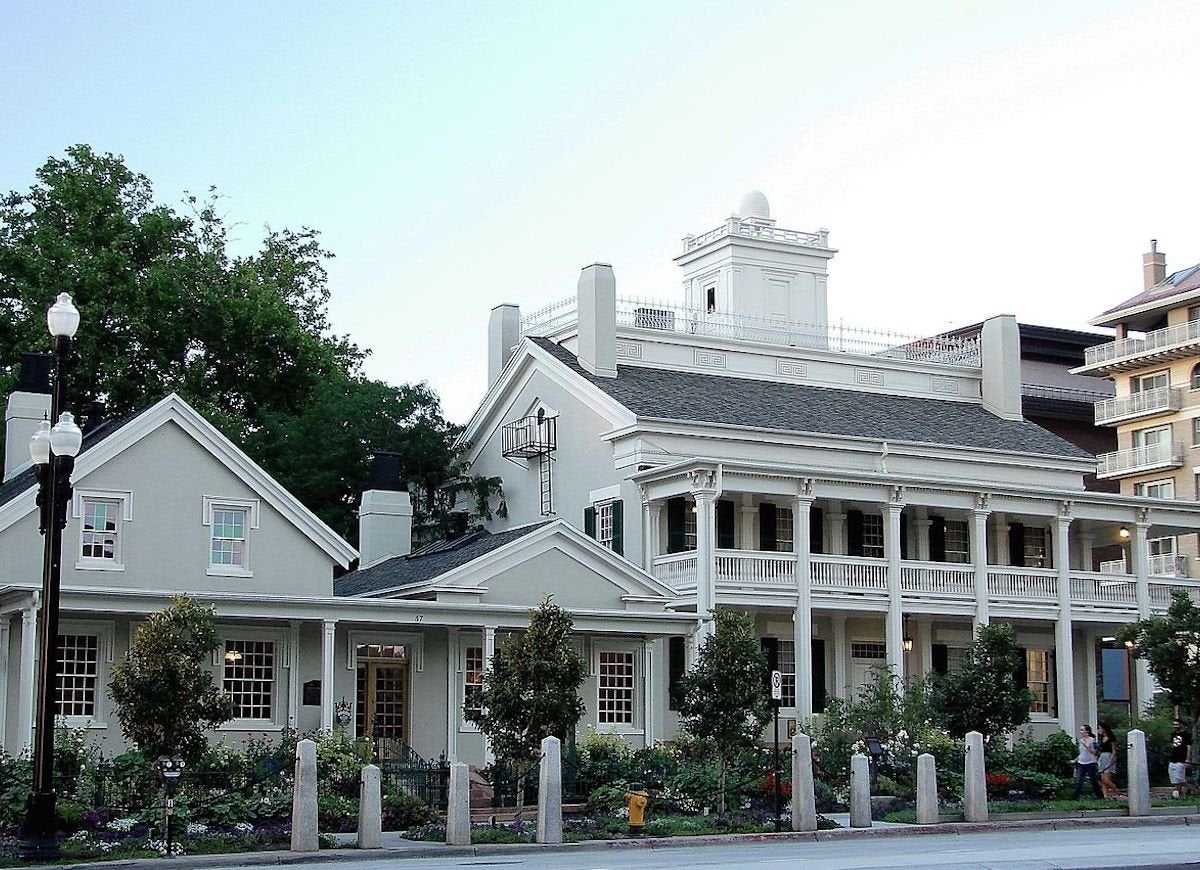
Built in 1854, Beehive House was the home of Brigham Young, a founder of the Mormon Faith and Utah’s first governor, as well as subsequent church leaders. The house’s name derives from a beehive sculpture on the rooftop, and the house and gardens are celebrated for both their spiritual and historic significance. Period furnishings, many original to the house, re-create the the home’s appearance in the mid-19th century. During the summer, the gardens host free concerts on Tuesday and Friday evenings. The property is open daily for tours, and admission is free.
Vermont – Park-McCullough House
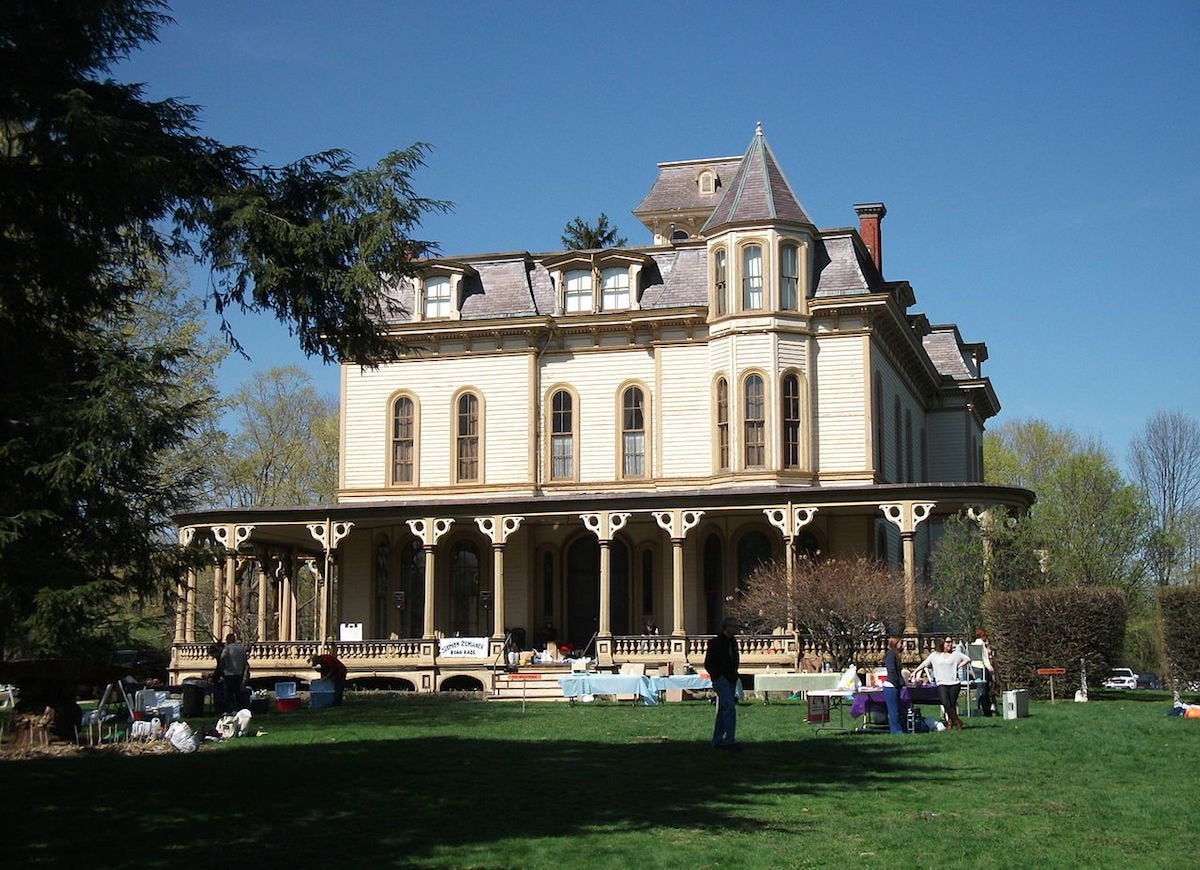
Wikimedia Commons via Doug Kerr
Completed in 1865, the Park-McCullough House is an exceptionally well-preserved example of Second Empire architecture, a style that arose in France under Napoleon III. The 35-room house, which took 18 months to erect, is situated on lush grounds. Both the home and gardens are open to visitors from late May through October; $15 per adult.
Virginia – Woodlawn and Pope-Leighey House
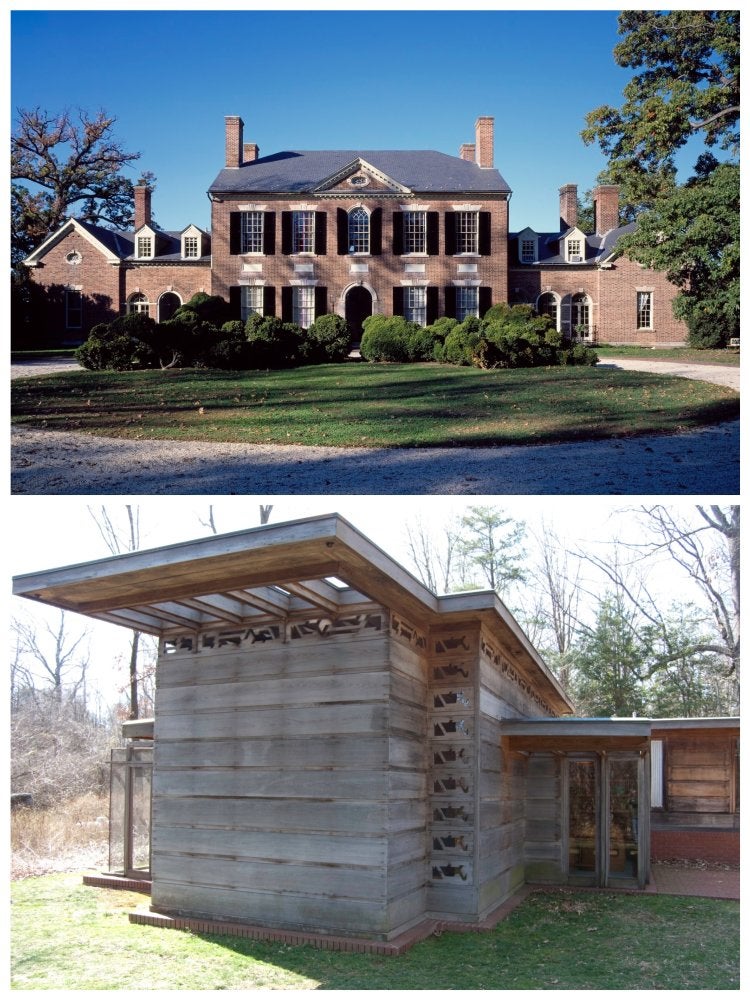
Wikimedia Commons via Library of Congress/Carol M. Highsmith and Cliff
Two homes, two wildly different experiences—in one tour. The Woodlawn Estate and the Pope-Leighey House are located on the same property in Alexandria. Woodlawn, constructed around 1805, was a present from George Washington to his nephew. The Pope-Leighey House was designed by famed architect Frank Lloyd Wright and completed in 1940. When the expansion of Highway 66 threatened the home, it was relocated to Woodlawn. Both properties are now sites of the National Trust for Historic Preservation and are open for tours Friday through Monday; visitors can choose to visit one or both homes.
Washington – Stimson-Green Mansion
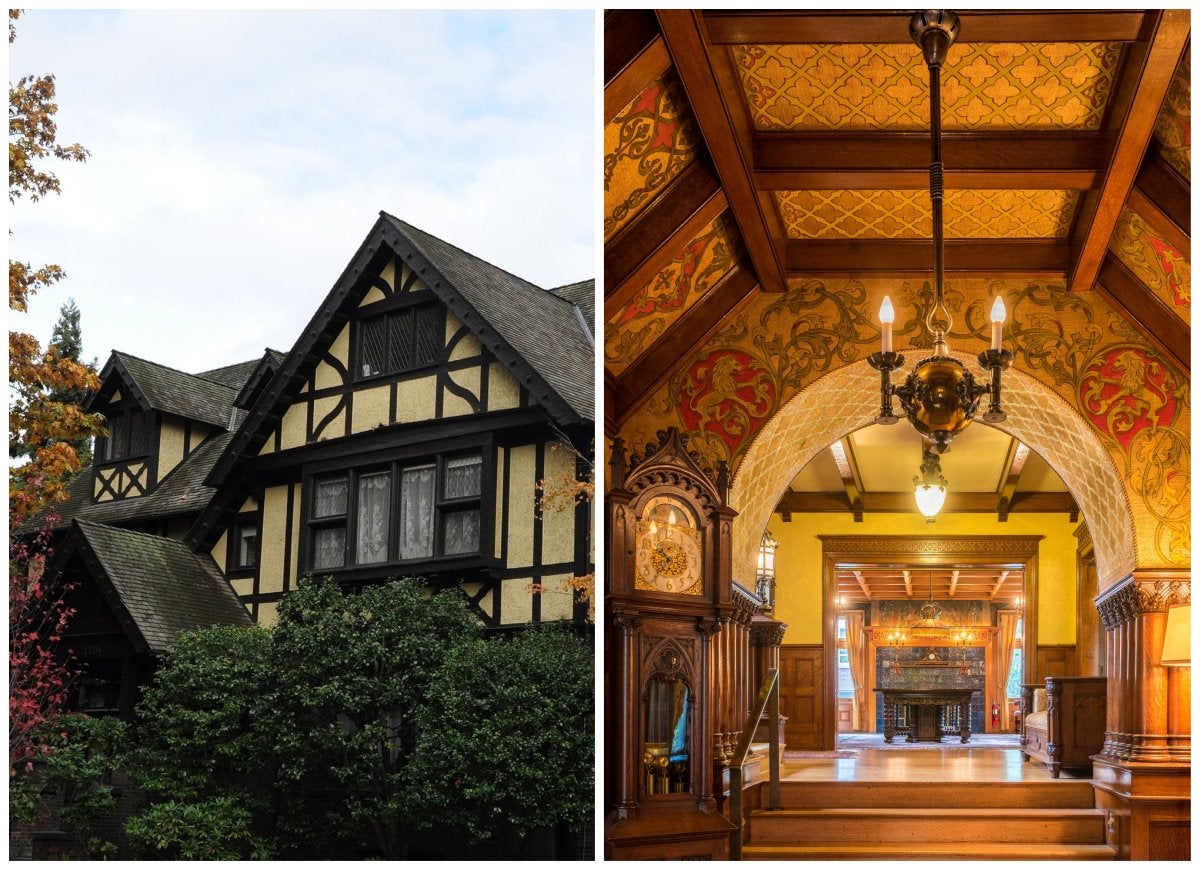
Wikimedia Commons via Joe Mabel and Nathan Tain
The Stimson-Green Mansion in Seattle is a hodgepodge of different architectural styles, primarily Tudor and Gothic Revival, but with splashes of Moorish, Renaissance, Neoclassical, and Romanesque influences. Somehow this eclectic mixture blends to create a beautiful, unified whole. The home, completed in 1901, is located in the First Hill neighborhood, so you can also explore the Frye Art Museum and Seattle’s Town Hall while you’re in the area. Today, the home serves as a community resource—it’s made available as a free meeting space for nonprofits—but it’s also open for tours. Tour dates are sporadic and are posted on the website of the Washington Trust for Historic Preservation.
West Virginia – Millionaire Row
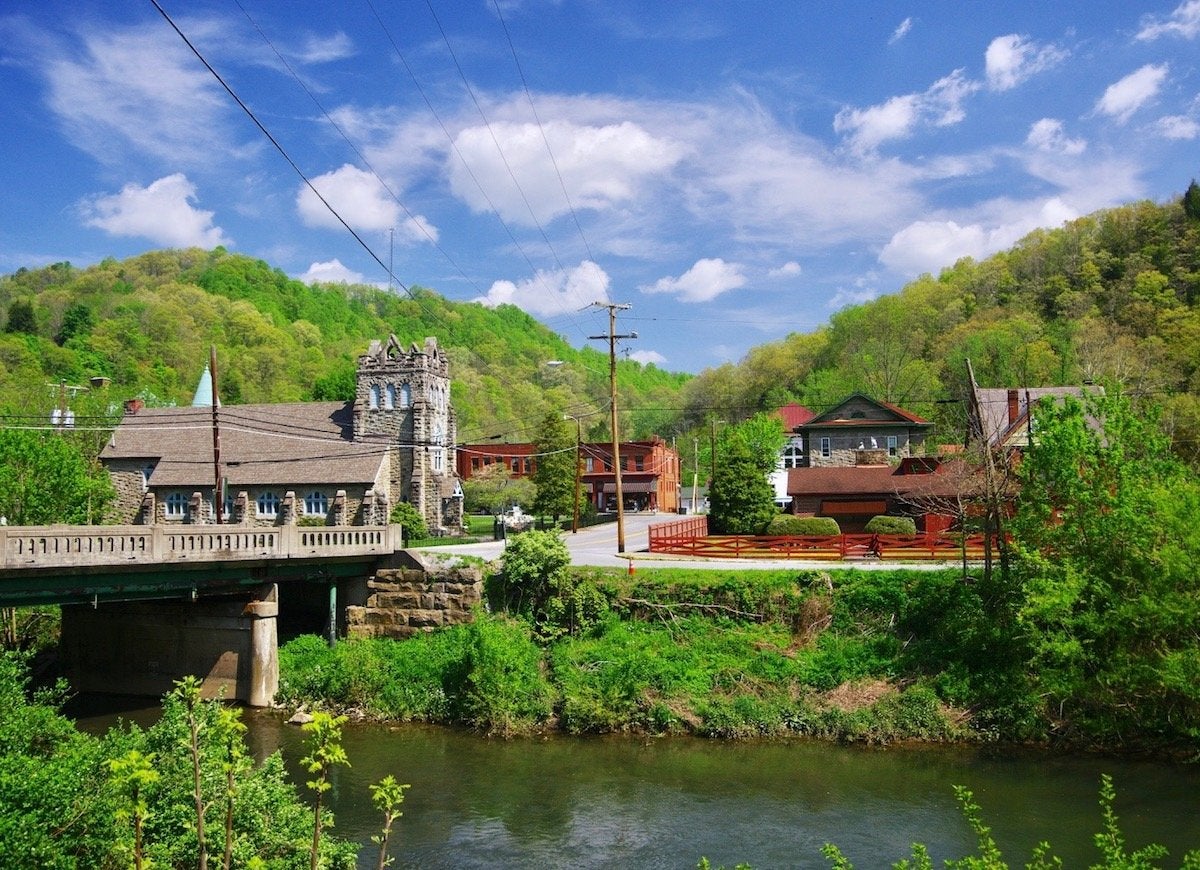
Wikimedia Commons via Brian Stansberry
If you find yourself in Bramwell, stroll down Millionaire Row, where coal barons built lavish mansions at the turn of the 20th century. The small town, which was once home to the most millionaires per capita in the United States, now hosts only a few hundred residents, but its famous buildings are larger than life. Plan your visit to coincide with the twice yearly historic homes tour, in June and December, when you can get an in-depth look inside the homes. Details are available at the Mercer County Convention and Visitors Bureau website.
Wisconsin – Taliesin
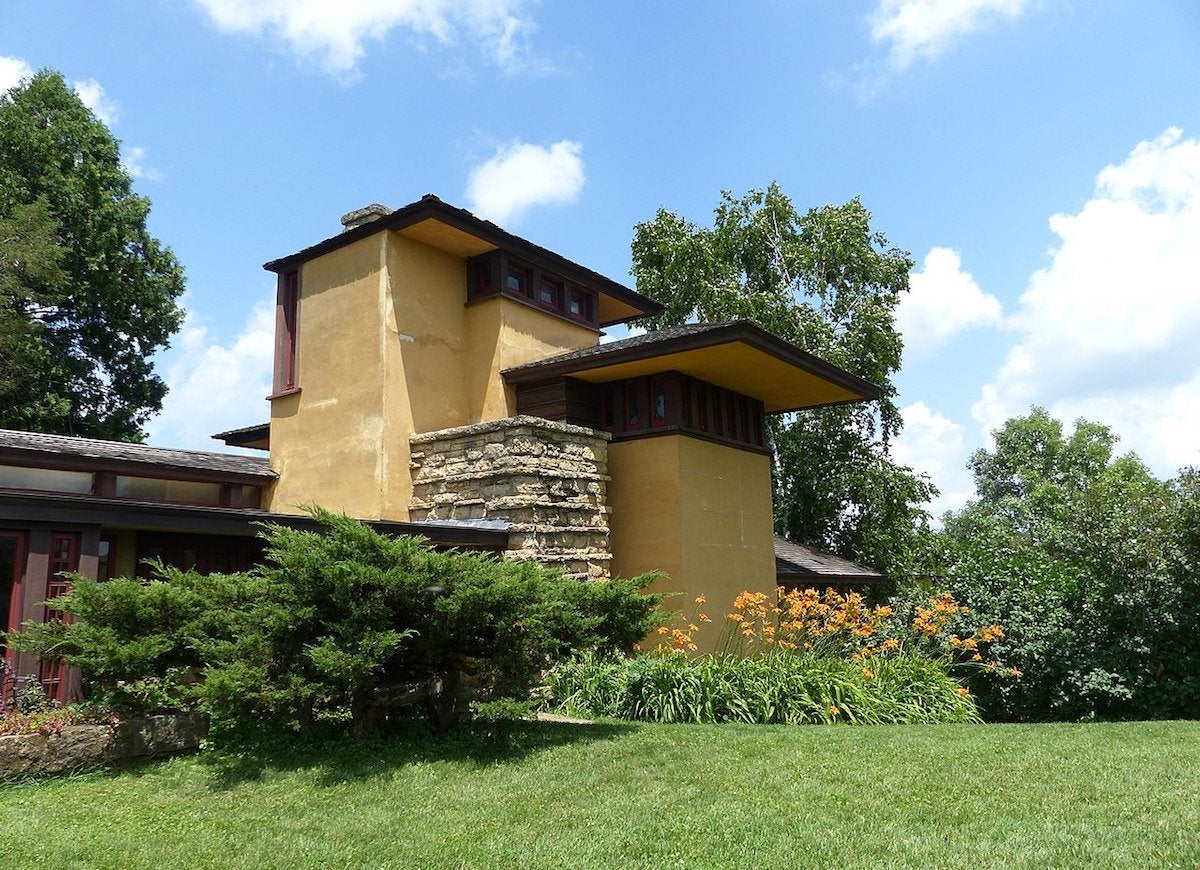
Wikimedia Commons via Stilfehler
Taliesin, is one of America’s most famous homes, built and lived in by Frank Lloyd Wright. The house and studio, which stand on ground that Wright had known and loved since childhood, were the backdrop to many tragedies, including arson, murder, and electrical fire, yet after each calamity, Wright rebuilt his beloved home. Wright’s philosophy of “organic architecture” remains woven into every beam and can be experienced firsthand through an extensive range of programs that include guided tours, culinary events, and concerts. Hours vary by season.
Wyoming – Quarter Circle A Ranch
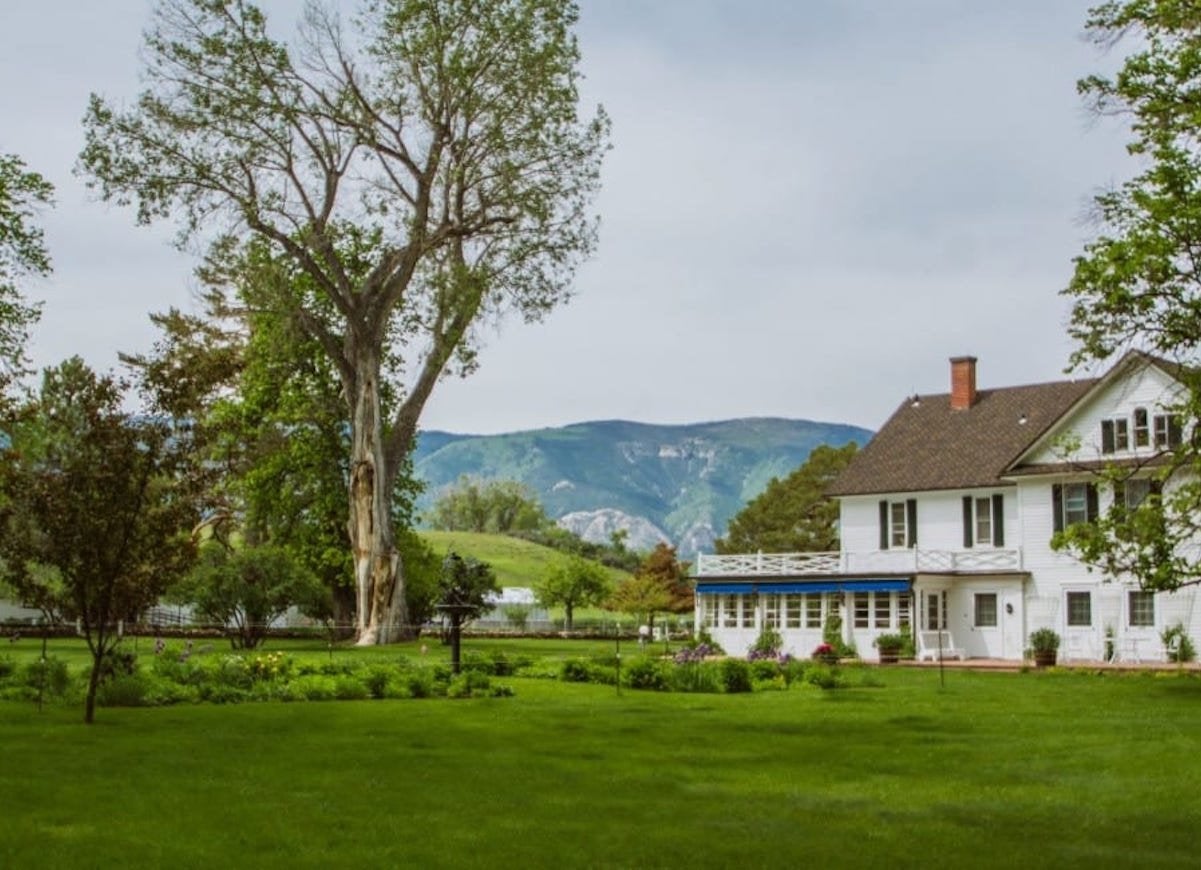
First a homestead, then a ranch, and now a museum filled with works of Western artists, the Quarter Circle A Ranch is the perfect blend of pioneer spirit and cultural insights. You can tour the entire 620-acre ranch, including the Brinton Ranch House, built in 1892, the museum, various outbuildings, the horse barn, and gardens. Tour availability varies by season.

All You Need to Care for Your Lawn & Garden
Keeping your grass green and your plants thriving doesn’t just take a green thumb—it starts with the right tools and supplies.